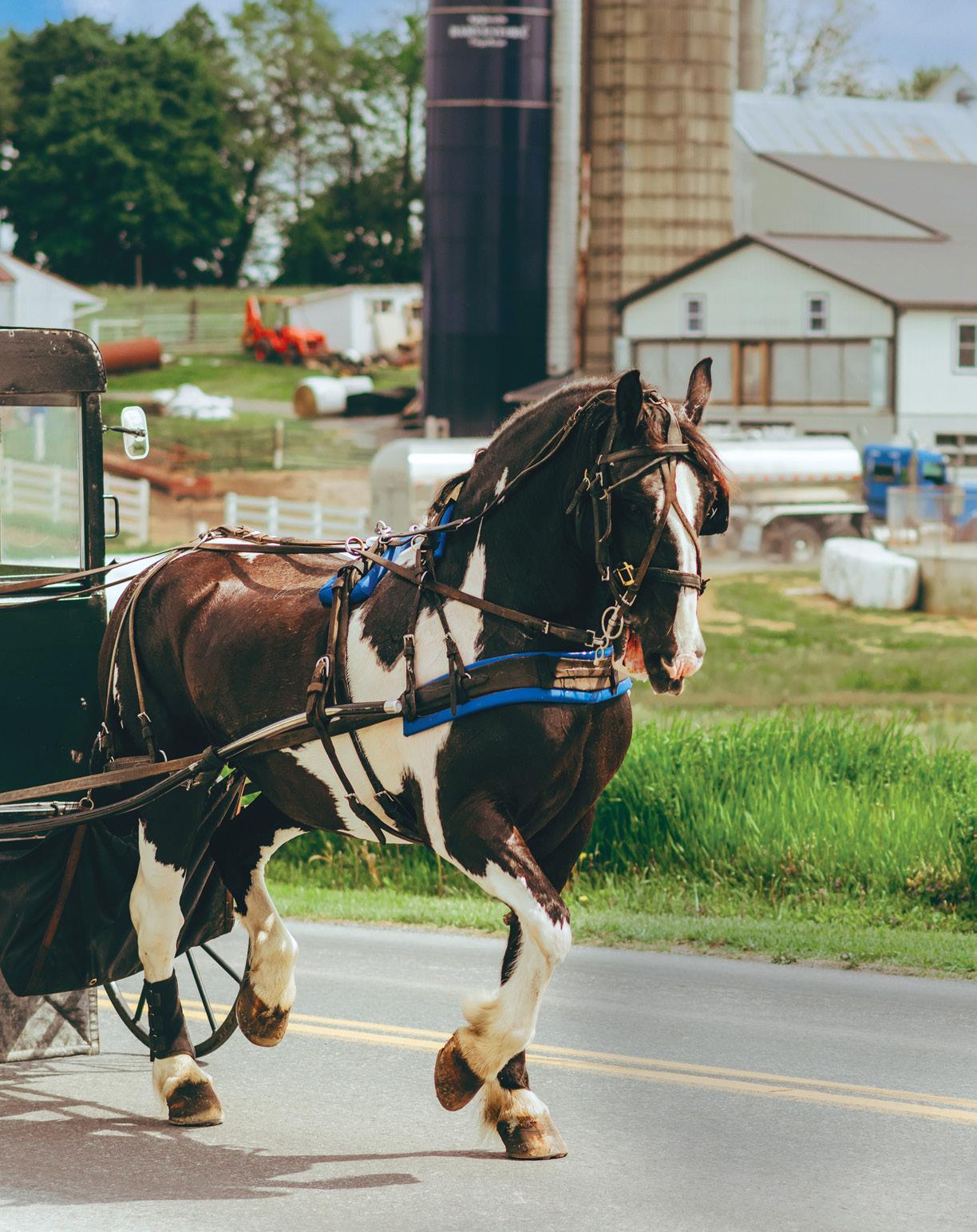












Our farm features 100 local family craft businesses offering hand made products. All locally made!
• Quilts to Brighten Your Home
Discover the beauty of Traditional Amish Quilts with wide selections of King, Queen or Single.
• Country Gifts & Crafts
The ultimate gift waits for you including souvenirs, Quillows, hand bags & purses, leather goods, things for the kids, for your baby, and more!
• Body Care
All natural body care made in Lancaster County, PA, including lotions, soaps, lip balm and more.
• For the Home
Decorate your space and bring it new light including kitchen items, home decor, pillows, lap throws, wall hangings, bird houses & feeders, brooms and more.
Mon.–Sat. 8 a.m.–5 p.m., CLOSED SUN Evenings by appointment only. For our catalog or information call

From Rt. 340 take Rt. 772 West. Right on Stumptown Rd. then right on Eby Rd. We’re the First Farm on the Left — LOOK FOR OUR SIGN! Whether local or
Travelers have been traversing Lancaster County along Route 30 for well over two centuries. And for over 70 years, a very special building has signaled their arrival in Amish Country. It has a legitimate claim on being the area’s oldest visitor landmark. Most importantly, it’s the “place that made shoo–fly pie famous.” That iconic structure is the Dutch Haven windmill.
With a history dating back to the beginnings of tourism here, the building is rich in memories. From the time it started as a luncheonette in 1920 right up to the present, it has remained most famous for shoo–fly pie, served warm with whipped cream. The Dutch Haven shoo–fly pie has even been mentioned in a TIME magazine article.
Today, as soon as you walk in, you’ll be offered a free sample of that same delicious, gooey pie. Some 40,000 pies are baked annually, using the original (secret) recipe. Visitors are still encouraged to “Take one for yourself or send one to someone nice.” You can buy and ship pies home at the store or at their “online shop,” where you’ll find other local crafts as well.
Yes, Dutch Haven is much more than pies, with over 10,000 unique gift items, foods, and collectibles. Some of the most popular are jams, jellies, and canned goods, noodles, hex signs, quilted spice mats, Amish straw hats, jewelry and gemstones, Amish dolls, onyx and soapstone animals, trivets, Tiffany lamps, framed prints, plenty of T–shirts and
postcards, and a tremendous selection of Amish–made outdoor furniture. It’s an eclectic mix, to say the least.
As you explore, you’ll discover lots of other “surprises” around every corner. Expect the unexpected! And don’t forget the Amish–style root beer in the barrel.
Dutch Haven is now open Monday and Thu r sday 10 a.m. - 6 p.m., Friday 10 a.m. - 7 p.m., Saturday 9 a.m. - 7 p.m., Sunday 9 a.m. - 6 p.m., and closed Tuesday and Wednesday. Visit our website for information. For more info about this Lancaster County landmark, call 717.687.0111. Look forward to your free sample when you walk in under the welcoming arms of the windmill for this truly is the place that made shoo–fly pie famous.
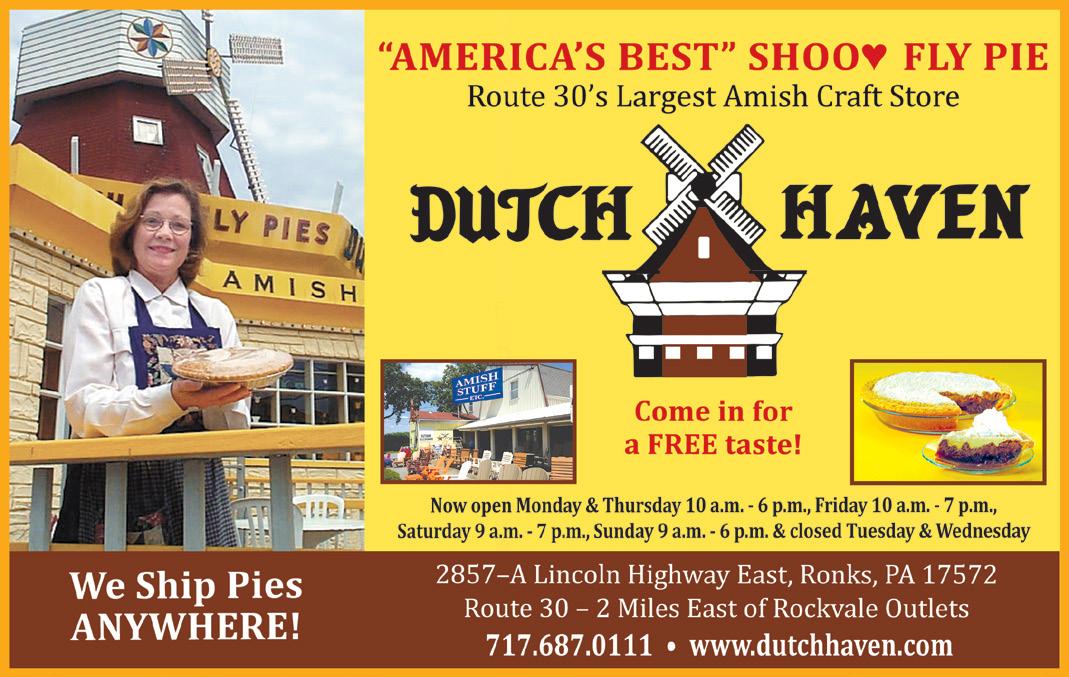





“Ride back in time, before the car or plane was ever imagined...”
Did you know?
Aaron was Jessica’s first horse!?
Embrace the moment and travel the countryside in our locally made horse drawn Amish carriages!

Born a small town girl, it was Jessica's dream to own a horse and carriage where she could share our lifestyle with others. She and her siblings attended a one-room schoolhouse and experienced the rigors of winter and hot summers. At the young age of 14 when her eighth grade education ended, Jessica had the opportunity to select the interior color of her buggy, choosing which style wood dashboard she wanted, and items such as a speedometer versus hand-powered windshield wiper! YES, even 30 years ago every family custom ordered the interior design of their Amish carriage. An opportunity presented at Plain & Fancy Farm to open a carriage business for visitors. In the next moment, Jessica found her favorite horse and named him Aaron, and soon began offering a carriage ride experience to travelers who were seeking to learn more about the Amish, Mennonites, and Old Order Brethren of Pennsylvania. Tracing our heritage back through Pennsylvania Dutch trails, to the Dutch Brethren of the Netherlands, Germany and Switzerland, Jessica and her dad had a new found joy of telling others about our way of life.
Today, Jessica's family lives in one of the oldest known standing homes in Lancaster County. It's now been over 31 years that the family has maintained the passion to share the Christian faith and "reasons" for living a Plain lifestyle. Within those years, Jessica and her five siblings are now parents to a combined 15+ children! Every few years another one of the children got to start learning how to drive a horse. In Lancaster County, you will see children as young as 6 or 7 years old driving their miniature pony to town!
Just as we continue to grow and develop, our communities continue to adapt to newer technology that may be permissible to utilize within the home or at work. It is important to understand that Amish and other Plain community members do not have a specific religious belief against technology. Their faith in the New Testament teaches them to follow verses such as John 15:19, to be in the world, but not of the world. No matter the progression, the simplistic lifestyle still holds strong! On our ride you'll have the opportunity to ask questions about day to day life, Don't forget to ask about the electrical sources in our homes (electrical wires are still non-existent).
In Jessica's home, and in a select few of the Plain churches, children are permitted to go to school beyond eighth grade. When Jessica had the opportunity to do local farm calls with a veterinarian, she found a love of medicine and caring for our horses.
Once she obtained her vet technician degrees, she worked five years in a horse operating room. She quickly discovered her true passion was caring for not just animals but humans also. Being the eldest sibling, she led by example and soon her next four siblings followed suit in pursuing healthcare degrees. Jessica’s sisters remain in Lancaster County practicing nursing within the local communities.
Today, you may see Jessica or her youngest sister Miriam offering buggy rides. This is your full opportunity to learn first hand about our childhood and the Christian beliefs that still hold true to us.
No matter the stage in life or agenda of the day, guests, locals (and even our drivers) find riding in a horse drawn carriage to be very relaxing! Even after thousands of carriage rides, Jessica, Sarah, Rachel, Miriam and their two brothers still love taking an evening joy ride in the carriage. When you come to our buggy ride, every ride begins with a ride through our covered bridge!
As Jessica and Miriam continue to expand our rides, we now offer many public, private and “themed” buggy rides. Inquire about scheduling your next special moment and create memories to last a lifetime!

We have team carriages so your group can ride together! Group rates available for 20+ riders.
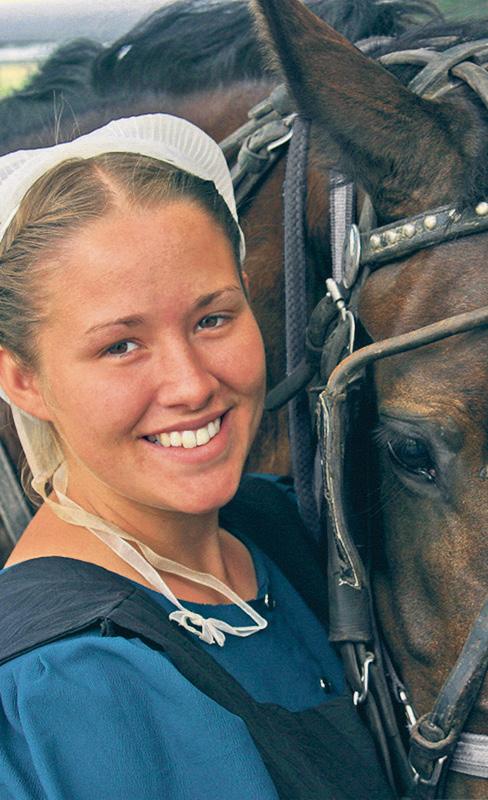










Monday–Saturday 9am–5pm Sunday 10am–4pm
Country & Cookie Tour
Adults: $18.00 Child: $12.00 (age 3-12) 2 & under: Free
A 30-35 minute tour passing a cluster of Amish homes and businesses in an all Amish area. Travel our country roads, the way we travel! Cookies, snacks and drinks are USUALLY available for purchase, depending on our Amish neighbors availability.
Amish Farm Tour
Adults: $35.00 Child: $16.00 (age 3-12) 2 & under: Free
A 50-60 minute tour that stops at a local farm! Experience our way of life on a real working Amish farm. Tour the barn, and see the cows, chickens, goats, and horses. Discover life without electricity and how the Amish remain separate from traditional American society!
The Sunday Ride
Adults: $20.00 Child: $12.00 (age 3-12) 2 & under: Free
A 30-35 minute tour passing numerous Amish farms. Our local drivers can answer your questions and talk to you about points of interest.
For a truly unique experience, book your own private tour, with your own driver, horse, and buggy. Our guests call it “ unforgettable”!












By Ed Blanchette

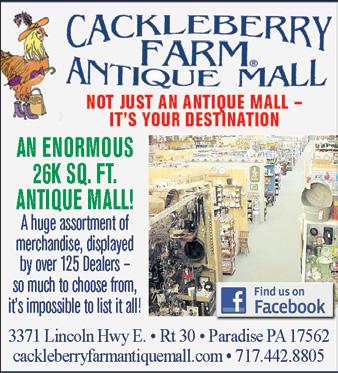


Do you enjoy searching for antiques? Perhaps you are looking for that special something, or you just enjoy searching for a surprise to add to your home decor. Maybe you hope to find an item worthy of an “Antique Roadshow.” Whatever you discover, once you find it, it becomes your personal treasure. What makes Lancaster County such a great place to go antiquing? One obvious answer would be that this area has a rich history going back hundreds of years to the first settlers in the early 1700s. Many of us have stuff in our attics that we have forgotten about, or inherited. Who knows what may be out there either at a yard sale
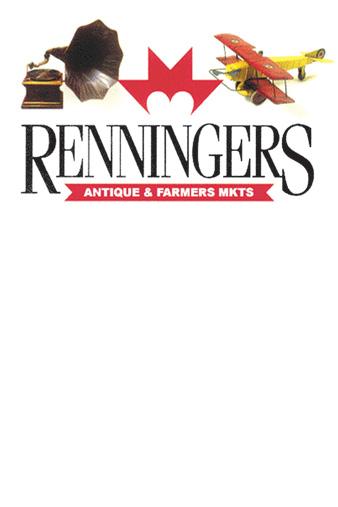
or an antique shop? Here in Lancaster County we boast thousands of antique shops and dealers. The Adamstown area alone has over 3,000 antiques dealers, and is known as Antiques Capital, U.S.A. The many locations stretch out along Route 272, just off Pennsylvania Turnpike, Exit 286.
Whether you are after a rarity, or just something old that intrigues you, you’ll find everything from sheet music to music boxes, pocket watches to kitchen sinks, nostalgic clothes to beautiful wardrobes to hang them in. Glassware, crafts, toys, clothes, artwork, china, quilts and fabrics, memorabilia...the list is endless!


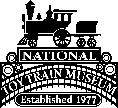

By Clinton Martin
The “Loblied” (or Hymn of Praise) is probably the most “famous” Amish hymn. “Famous” might be a bit generous, as hardly anyone would sit around listening to traditional Amish hymnody just for fun, though I did find recordings of the song are available to stream on Spotify, so someone somewhere must be tuning in now and then.
The Loblied can be found in The Ausbund, the Amish community’s original hymnal, in continuous use for around 450 years. It is song number 131. Amish Country News owns both German, and German-English copies of the book, and the English translation doesn’t always flow very well, since German word structure is so different, and the translation is word-for-word. But suffice it to say, the hymn is about praising God while enduring suffering. The hymns are sung in German. The English words are only there to remind those Amish whose High-German has gotten a bit rusty of the meaning of what they are singing.
All Amish people learn PA Dutch, or PA German, naturally as a first language, but this is not High-German. They learn English at school (if they haven’t mastered it already as a child beforehand) but they learn HighGerman at school. After graduating post eighth grade, some Amish people
use High-German very little, so it gets rusty. Furthermore, contemporary HighGerman sources no longer use the old gothic script that the Amish continue to use in their High-German texts.
The Ausbund is a collection of hymns written, mostly by Anabaptist (forefathers of the Amish) adherents who were imprisoned for their beliefs, tortured, and often executed. Thus, the hymns have a hopeful, yet lamenting, praising, yet sorrowful tone.
At nearly every Amish church service, the Loblied is the second hymn sung. The Ausbund does not have musical notes in it. It simply has the words of the hymn. The tune is learned through repetition and handed down orally by tradition. Who knows if the way the tune goes today has changed much from a couple hundred years ago? Maybe, maybe not. But there is definitely a certain way it is sung now, which each generation learns by doing.
The singing is long, drawnout, and almost chantlike. Songs can take a number of minutes to complete. A songleader will begin each line, and the congregation will then come in and finish it out in unison.
There is no four-part harmony. All is sung as one. No musical instruments accompany the singing.
Copies of the Ausbund can be purchased at Amish bookstores, and there is a fascinating book, The Amazing Story of the Ausbund, which is a well-researched title explaining the origin and history of the hymnal, which is likewise available at Amish bookstores (or the latter can also be had simply through Amazon or other “secular” booksellers.)
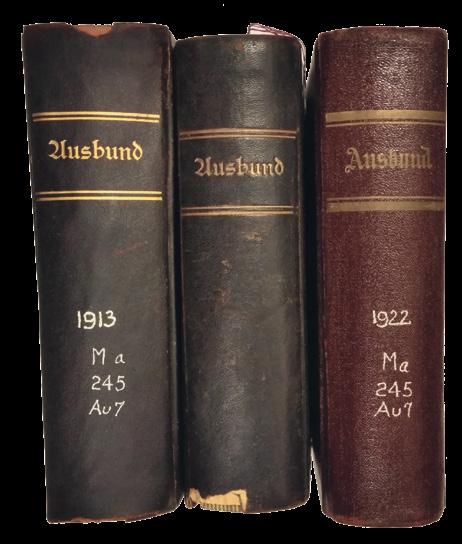

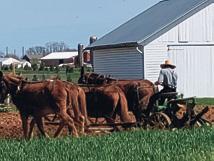








REVISITED
In the previous issue of “Amish Country News”, for June, we revisited the questions given during my travels in and around “Amish Country” from visitors and even some locals of what is proper or allowable for photographing the Amish people within their communities. As you know, we always attempt in making it our utmost goal here at “Amish Country News” to be thoughtful and respectful regarding our articles, historical references, artwork, and all the photographs that are submitted, taken, and used in and throughout our publications.
We even have a special continuing section in each issue categorized as, “Reminders”, that assists in making our readers and visitors to the Amish communities aware of some of the simple etiquettes to bring to mind. This way we all have a respected and civil guide for interaction between peoples, be it Amish, Mennonite, or English and the continuing goal of respecting each other’s privacy, space, and dignity.
Again, in the July Issue, as promised, please enjoy part three of this “revisiting” of the article and subject from our friend Brad Igou and his previous contribution to “Amish Country News” regarding the on-going questions of photographing our friends in the Amish communities. So, without any further delay, please enjoy this, the third of four parts. Thank you.
By Brad Igou
Most visitors to Lancaster County find it difficult not to take photographs of the Amish. Yet, if there is one thing that appears to bother the Amish, it is people trying to constantly, and sometimes secretly, take their picture. (There are even stories of tourists paying or bribing Amish children

to be photographed.) This aversion to photographs is often explained as being based on the Second Commandment, “Thou shalt not make to thyself a graven image, nor the likeness of anything that is in heaven or in the earth beneath.”
As most people know, Amish children often played with faceless
dolls. While there are explanations for the lack of a face having to do with the doll’s becoming a “likeness,” others say it was simply a custom. Today it is common for the Amish to buy or make dolls with faces, and there are examples of Amish dolls with faces sewn or drawn on dating back to 1900.

Elmer Smith in his 1961 book The Amish Today feels a short story published in a leading national magazine led people to such a conclusion. The December 1937 Scribner’s story called “Suzie” told of an Amish girl who received a doll from her teacher as a Christmas gift. Her father removed the head and replaced it with a stuffed stocking since “only God can make people.”

Smith concludes that this idea that dolls are graven images is not nearly so widespread as most people think. Now we will look at what one Amishman himself has to say about it all. Elmo Stoll, writing in the March 1987 issue of Family Life , an Amish magazine, took on the entire issue of graven images, photography, and the Second Commandment. He notes that certainly a painted portrait
would be no more permissible than a photograph, that x-rays and toy animals are images, and that stamps and money have likenesses of people on them. He writes that “the second commandment is not about taking snapshots. (If it were, what were the poor people supposed to make out of it for 5,000 years before the comparatively recent invention of the camera?)”
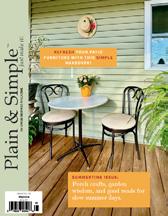




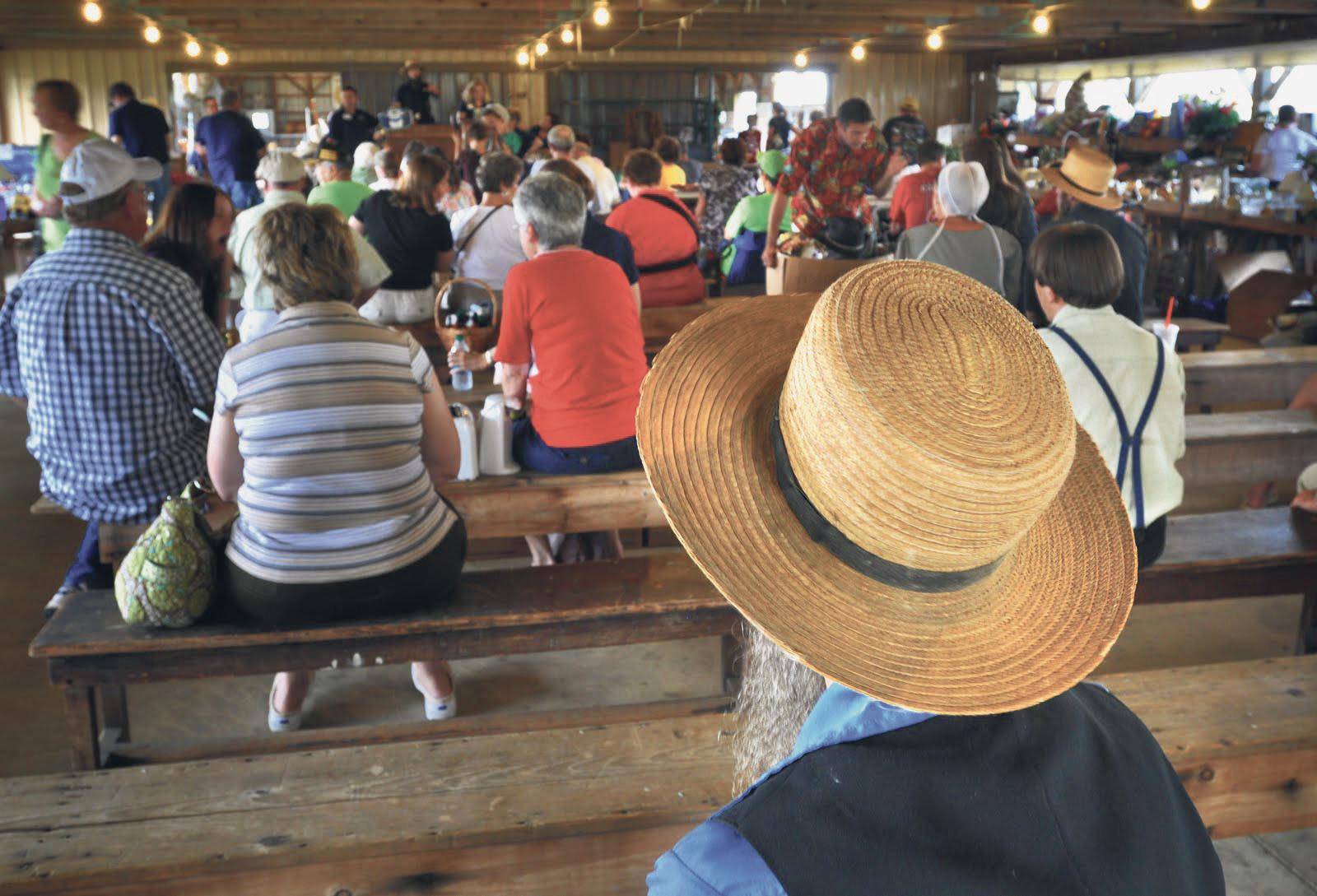
By Clinton Martin
Have you ever wanted to attend an Old Order Amish church service?
Maybe check out an Amish wedding? Or perhaps, experience what an Amish backyard BBQ might be like? Well, you just don’t walk into such settings. You need an invitation, so chances are you’ve never rubbed elbows with the Amish in any of these social gatherings.
But, if you want to socialize in an Amish setting, it is actually quite easy. Go to an auction. Nobody puts on a good country auction quite like the Amish. No invitation needed. Everyone is welcome. Whether “English” (non-Amish) or Plain, no matter if you drive four wheels with a motor or a horse-drawn conveyance, you can attend an auction and experience a slice of the traditional PA Dutch life.
I love going to Amish auctions. Sometimes I even buy something. I always get a bidding number just in case, though on more than a few occasions, the only thing I opened my

wallet for was the food. But, I’m getting ahead of myself.
I recently went to an auction held at an Amish farm, a bit of an unusual auction because the real estate itself was
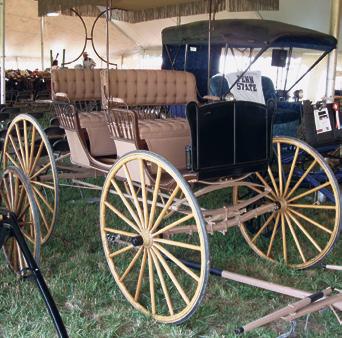
not being sold, only farm implements, household goods, hardware, etc. It was basically a big auction selling a bunch of
stuff, but the home and farm real estate was staying put. Now, the auction listing didn’t actually specify that it was an Amish farm, but the last name of the sellers was Lapp (a very common Plain name) and Tim Weaver Auction Service was the auctioneer, a common purveyor of such services to the Amish. I found the auction listing online at www.AuctionZip.com but the Lancaster Newspaper also publishes upcoming sales.
When I arrived at the farm, there were helpful homemade signs indicating a parking area for the horse-and-buggies off to the left, and a parking area for vehicles off to the right. I was glad I was in my truck as I could tell getting back out of the field set aside for parking was going to require four-wheel-drive. It was quite muddy, and I spied a minivan which had sunk down in to the wheel wells already… hopefully he buys the tractor going up for sale. He’ll need it to drag his own car out of the mire. The horse and buggy area was
interesting in that as people parked their carriages, they unhitched their horses from the buggies, bringing their horses over to a big flat farm wagon that was covered in hay for the horses to munch. The horses seemed to be socializing and hanging out with each other as much as a group of humans would. I wondered if these horses know each other from other Amish gatherings? Do they have their best friends? Are there equine “clicks” that

gather together? And, how in the world do the Amish folks know whose horse is whose? Don’t all the chestnut browns and mahogany hides blend together? I suppose not. I guess everyone leaves with the horse they came in with.
It is easy to know where the action is. Just listen for the sing-song drone and gab of the auctioneers, and you’re heading in the right direction. So I crossed the road, and walked up the hill (this was a typical Amish farm with a “Swiss Bank Barn”) and at the top of the hill inside the barn, I found two simultaneous auctions going on. One side of the barn was household goods, dishware, dry goods, etc. whereas the other side of the barn was hardware, tools, materials, and farming necessities. I registered and got a bidding number at the Tim Weaver trailer, and found a spot among the straw hats in the barn to observe the goods coming up on the block.
I was one of about 10 English people attending, and I counted about 100 Amish. The auctioneers were trying their best to get some bidding action going, but I could tell most of the people there were just hanging around talking with their friends, catching up, sharing the latest
gossip. It being in PA Dutch, the German dialect the Amish use among themselves, I can’t tell you what the big news of the day was, but the auctioneers were calling everything in English, so I could follow that. Every now and then, an item would come up that snapped people out of their chattiness and the auctioneers would get a good price, but most of the stuff was going really cheap. Good for the buyer, not so much for the Lapps!
It was fascinating for me to see a Plain lady, an employee of Tim Weaver Auctioneers, recording the items sold, bidders who won, and prices obtained, on a wireless laptop. I wondered where she learned to type so fast! When two gigantic sacks of seed corn came up for auction, and the bidding got serious for a minute, I decided it was time for me to head to the food concession. What in the world would I do with enough seed to plant 10 acres of sweet corn? I’m more of an “eat-corn” person rather than a “plant-corn” person.
Luckily for me, the food wagon on site had that delicious, amazingly unique Chicken Corn Noodle Soup that the Amish are known for in Lancaster County. As is the case at these auctions, the food stand was run by amateurs, in other words, it was a fund-raising opportunity for the Amish community. In this case, the food options were being sold as a benefit for the local one-room school. The Amish school itself was literally right next
to the farm. So it was easy to imagine the mothers of the current student body at the rural school donating their time and ingredients to create the delicious menu
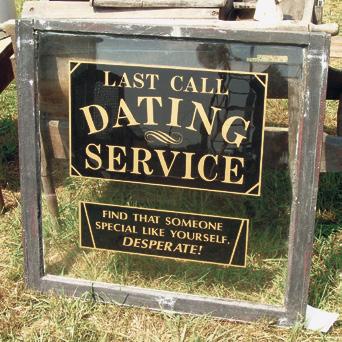
of hot and cold foods, not to mention the impressive array of baked goods. In addition to the wonderfully rustic chicken soup, I also enjoyed a sausage sandwich and a hot and fresh, right out of the kettle, donut. A man could develop a serious addiction to those things. Luckily, auctions like these are a common occurrence, but hardly a daily opportunity for gluttony.
In this case, they even provided a nice dining area, where food purchasers could sit down and enjoy their food. It was inside the basement of the house. A trained eye after going to enough of these events, I could tell the Lapps must have hosted



church the day before. This auction was also a little unusual in that it was on a Monday morning. Most weekday auctions are in the evening (so people can come after work) or on the weekends, when more bidders can show up. But in this case, the benches from the church wagon were still up in the basement, now a dining area, but surely a seating area for church the day prior. In fact, the bench wagon itself was sitting right outside the home. If it is going to be your turn to host
why not host them back to back, and set everything up once, and get twice the use out of it all?
I didn’t stay long enough to see some of the larger items sell. It would have been interesting to see what the Maytag Wringer Washer went for. These ancient clothes washers are still popular among Lancaster County’s Amish, though not all Amish housewives use them. But, enough still do to cause them to be sought after when


one is available. Or, the accompanying “spinner” which is essentially a super-sized salad spinner for clothing, taking a lot of the water out of the clean clothes before

hanging out on the line. Amish don’t have automatic driers like we English do, but they have jerry-rigged automatic washing machine bodies set to operate off an air motor to spin the drum and whisk away excess moisture out of the clean clothes prior to hanging. It dries so much faster on the line when it has been spun a few times beforehand.
I’m sure the tractor went for a decent price as well, though Amish farms use tractors for their stationary PTO power more often than for actual field work (where horses and mules still reign supreme.) So, the tractors on Amish farms are often rather rough because they don’t
have to be pristine. Plus, the absence of pneumatic tires would make for a very rough ride on a farm where the tractor is in constant motion. The tractor on this farm happened to have solid rubber pads on the treads of the steel wheels, so I suppose there was some sort of shock absorption offered, but certainly not much.
In the end, I settled up my bidding number at the auctioneer’s trailer, and left with the rough-hewn wooden storage box I bought, one of those items that was never made to be folk art, but after who knows how many decades of use and abuse around the farm, had taken on an aura of country chic, primitive cool, folksy artistic creation.

So you want to socialize as the Amish do, want to see and be seen among the Plain crowd? Just keep your eye on the auction listings, and
go have yourself a ball. Just take enough cash in your pocket to at least enrich the for-a-good-cause food wagon!






Of the many unique village names that dot the Amish Country map, one of the more interesting is Bird-in-Hand.
The story of the town of Bird-inHand is as colorful as the name itself. To be correct, the town is really a village since it has no governing body. When Bird-in-Hand celebrated its 250th Anniversary (1734 – 1984), a commemorative booklet was put together. It outlined a brief history of the town…
Quakers and Swiss Mennonites were the early settlers. The Quakers built a meetinghouse and two-story academy, which stands today, next to the fire company. But over the years, the Germans “made the greatest lasting impact.”
A friendly relationship existed between the early settlers and the Shawnee and Conestoga Indians, who were the area’s first inhabitants. They taught settlers how to deaden trees, use deerskin, prepare corn as food, and use medicinal herbs.




William Penn, an English Quaker, had founded the colony of Penn’s Woods (Pennsylvania), and settlers began arriving from Europe in the early 1700s, moving westward from the port city of Philadelphia. English
“When the Old Philadelphia Pike became a well-established route of transportation for those traveling west to the Alleghenies, Lancaster became known as the gateway to

















July 18 & July 19
338 N Ronks Rd, Bird-in-Hand
Our community looks to support and uplift the less fortunate communities of Haiti. Using the community outreach of an “auction”. Friday at 4:30 pm, starts the kickoff with a BBQ Supper, a Singing group at 6 pm, then evening auction at 7 pm. Saturday 6:30 am to 9 am kicks off with a breakfast and the auction starts at 8 am sharp in the large white tent. Our auction offers a huge array of items such as tools, sporting goods, crafts, quilts, furniture, lawn & garden, sheds, tractors, equipment, food & much more!!
For additional details visit pahaitiauction.com. Tell them, “Amish Country
sent

>> Now Accepting Entries! << Got great photos? Send them to us and see your photo in the pages of Amish Country News and win prizes!
Visit AmishCountryNews.com for Photo Contest prizes and more info. Email your HIGH RESOLUTION ONLY photos in JPG format to clinton@amishexperience.com (minimum size 8x10 at 300 DPI). Put 2025 Photo Contest in the subject line. File names should contain your name. Include your name, address and phone number with brief details of location and subject matter in the email. No more than five photos can be submitted. LOW RESOLUTION PIXELATED IMAGES WILL NOT BE ACCEPTED.
Photos become property of Amish Country News / Amish Experience and may be used in upcoming issues, publications, and promotional materials.
the west.” The trip by stagecoach for passengers, or Conestoga wagon with freight and merchandise, lasted several days. Inns were built every few miles, identified with signs held by an iron pole or attached to the side of the building.
The reason for these signs was twofold. First, they could be understood by all nationalities. Secondly, many teamsters or waggoneers were poorly educated and could not read. If they


were given orders to stop at a certain inn, they could do so by recognizing the artwork on the signboard.
The old legend of the naming of Bird-in-Hand concerns the time when this pike was being laid out. Legend says that two road surveyors were discussing whether they should stay at their present location or go to the town of Lancaster to spend the night. One of them said, “A bird in the hand


































stardate: Amish 2100
By Brad Igou
None of us can really know what the future will bring, but the Amish always seem “behind” the rest of the world. Nevertheless, the Amish of today are quite different from the Amish of 100, or even 50 years ago. Indeed, if an Amishman came back from the past, he might be shocked to see how his brethren live today. But it is their ability to adapt and change that has helped them to survive and flourish in the 20th century.
The Amish population in Lancaster County, Pennsylvania, has doubled in the last 20 years or so. One Amishman even projected that at this rate there would be 480,000 Amish in Lancaster County before the year 2100 A.D. and one million twenty years later! He asks, “Lancaster, are you ready for that?”
Let us suppose that the Amish have continued to live “behind the times.” Because of this, they continue to fascinate the people of the future and to attract tourists. So let’s have a little fun with all of this and imagine what our lives and those of the Amish might be like in 100 years....

Now in the year 2100, cars are naturally something from a bygone era. The Smithsonian Institute in Washington, D.C. opened its National Museum of the Automobile several years ago in 2078, and it continues to attract large numbers of visitors. The visions of all of those old 1990’s science fiction movies have partly come true. We are all riding around in flying cars known as “airmobiles.” Naturally, any group of people like the Amish who continue to make use of cars, those land machines on rubber tires, attracts many a curious visitor. So today we will take off in our airmobile and fly over to Lancaster’s Amish Country.
Zooming over the huge sprawling city that makes up most of the northeastern United States, we begin to see patches of... could it be....farmland! Beyond certain stretches of forests and mountains that have been preserved, there is little in the way of open space anymore in this region. And with food grown almost

entirely indoors, farms are pretty much the stuff of history books.
The Amish had pretty much discontinued using the horse and buggy by 2060 A.D. Many experts were surprised they had held out that long. But the first booming airmobiles frightened the horses more than the cars had on the roads. In time, the car was hardly considered a worldly object, since they had pretty much begun to disappear. The Amish saw what was coming. As the “automobile” was being replaced by the “airmobile,” the Amish started buying up the last surviving car models. Needless to say, they got them dirt-cheap. People were happy to find anyone who wanted to buy their cars. Indeed, the Amish have kept many of the last cars from the mid21st century in superb condition.
Furthermore, seeing the demise of the car, the Amish started buying up the few remaining junkyards at bargain prices. (The Smithsonian people often come to them for advice and parts.) The car is as much a throwback now in the
space age as the horse and buggy were in the automobile age.
While sociologists predicted that the Amish would never survive if they switched to cars, they were wrong. In fact, the change to the car probably saved them. Just as in the old days, when rowdy Amish boys had cars, some of the rebellious Amish youth had started to purchase secondhand airmobiles. There were many flying accidents. It was at this
point that the church elders decided it was best to make the switch to cars and keep everyone “on the ground.” What with flying airmobiles owned by just about everyone around them, the Amish finally accepted cars much as their grandparents had viewed the horse and buggy... as a method to preserve a way of life “in the world, but not of it.”
After a visit to Lancaster County, many visitors go home saying that
there are valuable lessons to be learned from these Amish, who live in the old, traditional style of people in the previous millennium. Some tourists even tell their astonished grandchildren that they remember growing up this way! Others wonder if perhaps something has been lost with all the speed, technology, and progress that are now a part of our lifestyle in the year 2100 A.D.


By Clinton Martin
The Amish use of transportation from a bygone era continues to fascinate curious visitors to Lancaster County. The Amish simply won’t hurry up and get with the times. All cars, flying or terrestrial, operate without input from the occupant. AI has taken over, and all cars are driverless and operate autonomously unfettered from the passengers. A new age of convenience and leisure has entranced the “English” (Non-Amish) world, what with effortless transportation from one place to another while enjoying games, four-course meals, restful naps, or even some time hanging out in the alternate VR universe. Steering wheels are dust-collectors in museums.
The Amish have done what they’ve always excelled at… work-arounds and adaptations, harnessing (if you’ll excuse a pun!) what they want from modern

technology while placing limitations on what they consider a potential bad influence on their culture. Brad’s funny prediction of 2100, that by 2060 the Amish would have fully abandoned horses, was actually spot on—just off by 35 years.
In 2025, Japanese engineers working for Kawasaki (most Americans know the company for motorcycles) rocked the world with their innovative “Corleo.” A robotic horse, this semi-autonomous, hydrogen-powered wonder provided mankind with a four-legged, ride-on, horse-like robotic all-terrain vehicle.
The Amish immediately saw the value in this and replaced their living breathing (pooping, eating!) horses with the Kawasaki variety. The robotic horses could be ridden bareback, but more commonly among the Amish was the use of the traditional carriage, the
Horse and Buggy of the modern era. Corleo proved an excellent carriage horse. No vet bills. No hay bills. No hooves to trim, mane to comb, or teeth to clean. No Collick. No balk. No gout. Plus, Corleo learned the way home (thanks to onboard AI capabilities) just like real horses, so a sleepy teenager after a long night out would still get ushered home safe and sound, just like in the old days.
Tourists could still enjoy buggy rides, though some traditionalists wondered if something hadn’t been lost in the whole experience by the absence of the good strong loamy aroma of old sweaty horses. Corleo was after all quite clean and sterile.
In another 30 years, maybe the next publisher of Amish Country News will add their own spoof to this series… who knows what the Amish will be doing then!

is worth two in the bush,” and so they remained. The sign in front of the inn is known to have once “portrayed a man with a bird in his hand and a bush nearby, in which two birds were perched,” and soon was known as the Bird-in-Hand Inn.
The original hotel was destroyed by fire about 1851. By the following year, a three-story hotel was built to replace it. More recently, it was known
as Bitzer’s Hotel before becoming the present Village Inn of Bird-inHand, now on the National Register of Historic Places. The Historic Preservation Trust of Lancaster County noted that it “may be one of the few 19th century inns in the context of a small town in Lancaster County, which survives with a high degree of architectural integrity.”
The town post office was established in 1836 as the Enterprise








Post Office. “Enterprise” was then the official name of the town, until the final change back to Bird-in-Hand in 1873.
After a large fire in 1896, people discussed the need for a fire company. In the early days, hitting a circular saw alerted the men of a fire. The year 1916 saw the change from horse-drawn to motorized fire equipment. Today the Hand-in-Hand Fire Company remains a volunteer organization, famous for its delicious fund-raiser dinners.
The town of Bird-in-Hand remained relatively unknown until a musical called PLAIN & FANCY opened in New York. The show Playbill noted that “The action takes place in and around Bird-in-Hand, a town in the Amish country of Pennsylvania.” The cast was brought to Bird-in-Hand on January 17, 1955, prior to the official opening.
Today, the town of Bird-inHand is still small, said to have a population of only about 300 people. On any given day, there may be more visitors than inhabitants. Many are city folks who have come to enjoy the country atmosphere, history, and shopping. It is said that visitors “can still expect friendly shopkeepers, homegrown Lancaster County foods, and restful lodging for weary travelers.”
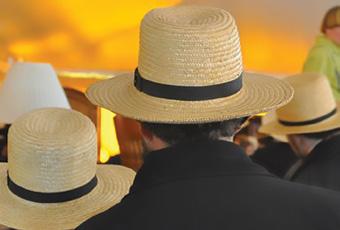


Although thousands of visitors come to Lancaster County to experience a bit of the Amish lifestyle, the Amish are a private people and find the attention somewhat disconcerting. It is important to respect their feelings while you’re visiting. With that in mind, here are a few tips for fostering good relations between the Amish and non–Amish.
NO PICTURES Please! Don’t ask an Amish person to pose for a picture. Most will politely refuse. It is against our Amish neighbors convictions to have their pictures taken, except in very special situations. Please respect this belief and do not take photos without permission, just as you would like to have your beliefs respected.
HOLD YOUR HORSES Driving along area roads, you will no doubt encounter numerous Amish carriages, or “buggies,” as visitors like to call them. Do not honk your horn, because the sound may frighten the horse and cause an accident. Instead, wait until it is safe to pass and then give the buggy plenty of room. Be sure not to cut back in the lane too sharply in front of the horse. The county’s roads are generally wide enough that you should be able to pass most buggies without much of a problem.
NO TRESPASSING Do not trespass onto private Amish property for a closer look. Amish homes are not museums, and Amish people are not exhibits. Respect their property and privacy as you would like others to respect your own. You can get a good sense of Amish life at many area visitor attractions and on guided tours.
WAVING Do not be offended if the Amish do not wave back to your friendly gesture. With all the people who wave to them throughout a day, they would be waving back all day if they did!
A FINAL WORD Remember the Amish are not on vacation and are not costumed actors. They are real people going about their daily lives. They are not here to serve as tour guides or attractions for visitors. This, after all, is their home, so please respect their beliefs and lifestyle.


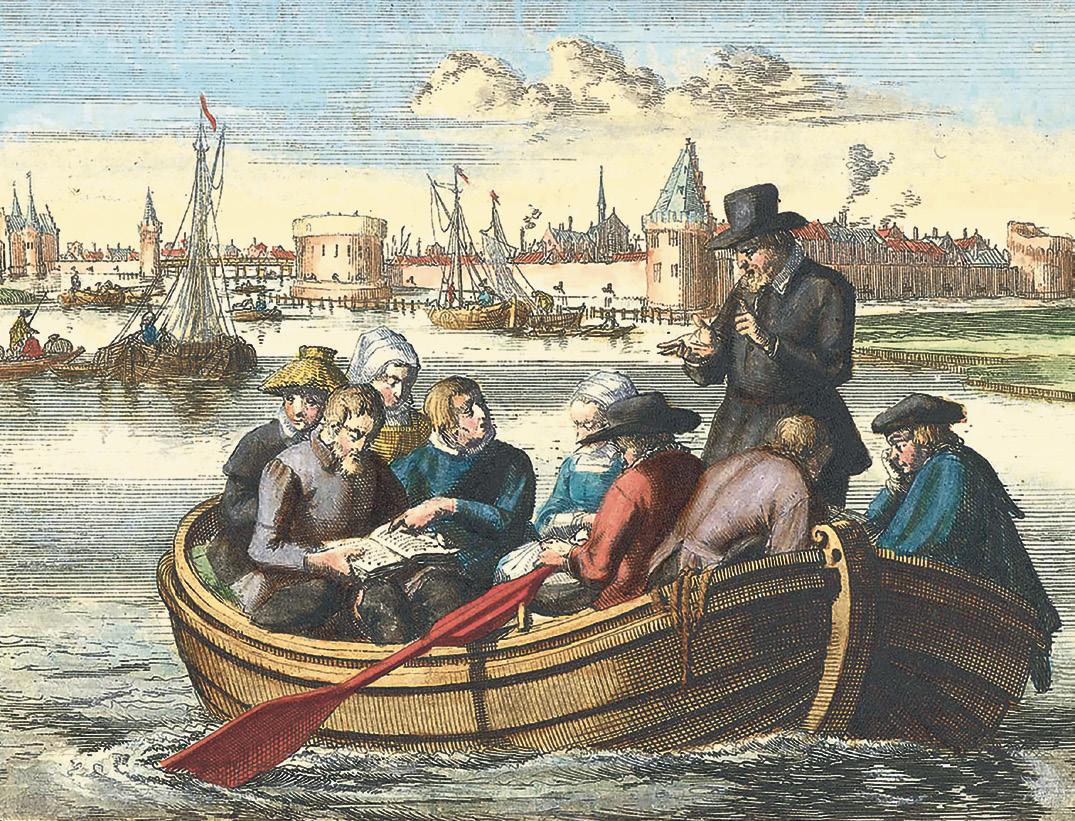

By Brad Igou
The Amish seem to lead a quiet and peaceful lifestyle, yet they are sometimes the victims of violence, in the October of 2006 Amish school shooting made it all too clear. This series offers a brief overview of the Anabaptist position of non-resistance in times of war and peace, from their origins over 450 years ago through the end of the 20th century.
Inflation, poverty, problems in the cities, overpopulation, religious disputes, threats to government stability, wars, problems between church and state... While this may sound like a list of problems from our world today, it was also the world of 16th century Europe.

In 1517, a Catholic monk named Martin Luther challenged the authority and
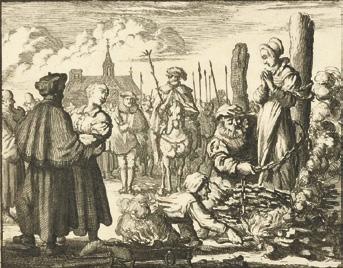
doctrine of the Roman Catholic Church. It was the beginning of the Protestant Reformation. A new invention, the printing
press, and the support of many German princes helped to spread Luther’s ideas.
Ulrich Zwingli, a Protestant priest in Zurich, Switzerland, taught “salvation by grace through faith alone.” But some followers were troubled by Zwingli’s alliance with the City Council. Zwingli felt God’s Kingdom on earth should be established by political power. Some of his followers believed that church reform should not come from the government, but that the church and state should be separate. They believed in pacifism and adult baptism. The Council demanded that these dissenters stop their meetings and baptize their children, since infant baptism was the main way authorities knew of the birth of children for their tax and census purposes.
On January 21, 1525, the dissenters secretly met and re-baptized each other to signify their adult commitment to their faith, and a Church not part of the State. Their radical defiance challenged the unity and authority of both, and their refusal to serve in the military was a distinct threat to the city’s safety.
The results? These Swiss Brethren were hunted down, asked to recant, tortured and put to death. Felix Manz was the first to be put to death by drowning in 1527. Soon, almost a thousand of these “re-baptizers” (Anabaptists) had been killed in Switzerland for their faith, all in an effort to bring these radicals back to the state church.
The Anabaptist faith spread from Switzerland to Germany and the Netherlands. In the following years, thousands were threatened or exiled, had their children taken, sold into slavery, branded, burned at the stake, drowned, or dismembered by both Protestants and Catholics, who viewed their “radical” ideas as dangerous thinking.
A book of some 1,200 pages was printed in the year 1660 in Holland to preserve the history of those who chose to suffer rather than to resist. This book, known as the MARTYRS MIRROR, is still found in many Amish homes today.
The Anabaptists were forced to worship in hiding, in each other’s homes, sometimes in caves. One story tells of a ferryman who allowed the Anabaptists to hold secret worship services on his boat. He was caught and condemned to death for allowing these activities.
But of the hundreds of stories, perhaps the most profound is that of Dirck Willems. Pursued by an Anabaptist hunter across frozen water, his captor fell through the ice. Willems, rather than escaping, returned to save his captor’s life. Willems, however, was taken into custody and later burned at the stake.
All of these experiences ingrained in the Anabaptists a suspicion of the world and government, as well as teaching them humility and a belief in separateness from and denial of the violence around them.
To this day, the Amish do not have churches in which to worship, but do
so in each other’s homes, much like the early Anabaptists. For them the church is not so much a building, as a community of believers.
Some of the imprisoned Anabaptists set to writing hymns in their cells.

These were soon printed and, with the addition of others, became the AUSBUND, the German hymnbook still used by the Amish today. Some 400 years have passed since these words were written. Still sung by the Amish
today at worship, they are reminder of the hardships and sacrifices endured by their forefathers...
We wander in the forest dark, With dogs upon our track; And like the silent, captive lamb Men bring us, prisoners, back. They point to us amid the throng, And with their taunts offend; And long to let the sharpened ax On heretics descend.
In time the death penalty ended, but Anabaptists continued to suffer wherever they went in Europe, largely because they refused to serve in the military. Some were imprisoned, branded with hot irons, or sold as slaves and separated from their families. For many, the guarantee of religious freedom would only be found in a New World, across the Atlantic Ocean, in a British colony known as “Pennsylvania.”
NEXT ISSUE (August): “Colonial America Through the Civil War”
Formulated and bottled in British Columbia, using a synergistic blend trusted for over 20 years.
Why Choose Heart Support?
For over 20 years, Heart Support has been trusted to help maintain a strong heart and healthy circulation. This potent liquid formula blends time-tested herbs—like Garlic, Hawthorn, Bilberry, and Motherwort—to support cardiovascular function, promote flexible arteries, and encourage balanced blood flow.





Helps maintain healthy blood pressure Supports healthy blood flow and nutrient delivery Traditionally used to nourish the heart and vascular system Liquid Formula – Fast Absorption, Real Results Made with nature’s most effective ingredients, this potent blend absorbs quickly and gets to work fast—just a few drops a day. Satisfaction Guarantee!





If you’re not completely satisfied, contact us for a full Hassle-Free Refund.




By Clinton Martin
The Amish would never do that, right? Visitors to Lancaster County’s Amish Country often wrestle with the “how” and “why” of the Amish. Prolific author of numerous books about the Amish, Donald Kraybill, titled one of his works, The Riddle of Amish Culture. Indeed, to many “outsiders” the Amish way of life does seem full of question marks… Sometimes, visitors are searching for hard and fast “always” and “never” definitions to how the Amish live.
The Amish never get their picture taken, right?
The Amish never fly by plane, right?

Well, not so fast. I personally know an Amish person who wanted to travel to Europe, on a “pilgrimage” of sorts to visit the places in Switzerland and Germany that were pivotal in the origin of the Anabaptist movement, to discover the history of his community. To travel to
his picture taken, got his passport, and did indeed go to Europe on his intended trip. Did he face censure from church leadership? No. They understood the reasoning behind “why” he needed his picture taken. He did not, however, fly to Europe. Rather, he sailed transatlantic on the Queen Mary 2, a ship that sails between New York and England, making the voyage over the course of 8 nights at sea. It is true that Amish people do not normally fly on planes. However, again I personally know an Amish person who did indeed fly out to the American southwest to be treated by an expert for a health issue that he was suffering from. There was an urgent medical need for him to be seen by this doctor, so his family booked him a flight, short notice, and got him out there
social media audience. I thought to myself, the Amish would never do that! Then I looked, and lo it appears yes, at least two Amish people would!
Meet Ben and Rose. They are of the Old Order Amish. They live in Lancaster County. They are members of the church in good standing. They are a married couple who play instruments, such as guitar, and sing. Their channel can be found at www.youtube.com/@ BenRose-music. Conventional wisdom would have said they would not play instruments (other than maybe a harmonica) once they joined the church. Additionally, conventional wisdom would have said they’d not be filming themselves, or allowing themselves to be filmed, to go on the internet once they joined the church. But that’s just the thing about “always” and “never” around the Amish. The community that seems quite rulebound to the outside world actually has some latitude when it comes to the “how” and “why.”


For those of you who would rather see Ben and Rose appear in person, rather than by viewing them online, you can sometimes catch them performing at Corner Coffee Shop, right on the “square” of the Lancaster County village of Intercourse PA. The coffee shop typically has “live” (amateur) entertainment on Friday and Saturday nights. Ben and Rose were known to play there. For the cost of a cup of coffee from the shop, and maybe a buck or two for the couple’s tip jar, you can hear the country music stylings of an Old Order Amish couple.
Never say Never with the Amish.
CACKLEBERRY FARM ANTIQUE MALL IS CELEBRATING THEIR 28TH YEAR! Located at 3371 Lincoln Highway East, Paradise, Pennsylvania, on Route 30. Four miles west of Route 41 and only six miles east of Rockvale Square Outlet Mall. They are only minutes away from everywhere and everything Lancaster County has to offer. It's Not Just an Antique Mall –It’s Your Destination!
WITH OVER FIVE MILLION DOLLARS OF INVENTORY, their huge 26,000 square foot facility houses a wide variety of antiques and collectibles, displayed by over 125 dealers featuring fine items such as: furniture, glassware, Railroad, Mining and Fire Fighting Memorabilia, coins, sterling silver, clocks, advertising, jewelry, fine china, toys, books, postcards, trains, Christmas, pottery, linens, primitives, kitchenware & much, much more! It is impossible to tell you everything they have to offer. You will be amazed at the quality selection.
HOUSED INSIDE THE ANTIQUE MALL, IS AN OLD TIME GENERAL STORE, which will take you back in time to the Mom & Pop stores of years ago. With a wide variety of antique and collectibles including Pharmacy, Tool Supply, Barber Shop, Hardware Store, Haberdashery and more!! They offer convenient parking for over 100 vehicles, with a spacious area for campers, trailers, and tour buses. You will find it such a pleasure to shop in their clean, climate-controlled, brightly lit and carpeted mall. Absolutely one of The Best shopping experiences in Lancaster County!
OPEN ALL YEAR: MONDAY THROUGH SATURDAY 9:30 AM to 5:00 PM, SUNDAY 10:00 AM to 5:00 PM, closed on Tuesday. Visa / MasterCard / Discover / Debit Cards accepted. Gift Certificates, Layaway and Shipping Available. For more information call: (717) 442-8805 during business hours or visit us on at CackleberryFarmAntiqueMall.com.




We have everything Lancaster County has to offer Come explore our huge 26,000 square foot antique mall—filled with the finest selection of antiques and collectibles in Lancaster County Pennsylvania! It houses a huge assortment of merchandise by over 125 dealers. There’s so much to choose from it’s impossible to list it all. And don’t miss our old time general store that’s full of vintage merchandise for sale.





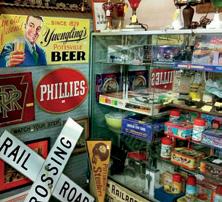


WITNESS the emotional story of an Amish teenager's struggle in Jacob's Choice, where he must choose between his faith and the modern world. 3–D sets, special effects, unique "ghost–like" characters, all on five screens.
EXPLORE the Amish Country Homestead, the region’s only Officially Designated Heritage Site Amish home then sit at a desk in the Fisher Amish Schoolroom furnished authentically with desks and more from an actual Amish classroom.
TOUR the magnificent back roads through Amish Farmlands with a certified tour guide in complete comfort onboard one of our 14 passenger busses.
SATISFY yourself that you’re making the most from your Amish Experience. Since 1959, the area’s first, and still foremost, interpretative source of Amish Culture.






Journey along back country roads, deep into the Amish Farmlands to discover sights rarely seen. Under the watchful eye of your certified guide, you’ll gain insights into the “how” and “why”of an ever–changing culture, and see at–the–moment activities of the Amish. If you’ve seen the Amish portrayed on the various “Reality” TV shows, and you wonder what really is true and not true about the Amish, this is the tour you won’t want to miss! We’ll debunk myths about the Amish and provide accurate, respectful, and authentic information, just like we have done for over 60 years.
Duration: 1 1/2 hours
Mon.–Sat. 10 a.m., 12 p.m., 2 p.m., 4 p.m. Sun. 12 p.m., 2 p.m., 4 p.m
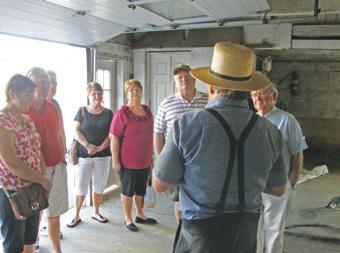
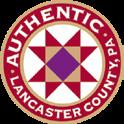
Rare is the opportunity to meet with Amish families willing to share their traditions and beliefs with you. In a group whose size is never more than 14, this is the only Amish Tour to be designated an official “Heritage Tour” by the County of Lancaster. Visit an Amish farm at milking time, stop at a Cottage Industry, and finally enjoy a visit and chat with one of our Amish friends in their home.
Monday through Saturday departing at 5 p.m.



The SuperSaver Package includes the Amish Farmlands Tour, the acclaimed “Jacob’s Choice” at the Amish Experience F/X Theater, and a tour of the Amish House & One–Room School.
Drive along the area’s only AAA Scenic Cultural Byway, and when you’re mid–way between Bird–in–Hand and Intercourse, you’ll discover the ten pristine acres known as Plain & Fancy Farm, and home of the Amish Experience Theater, Country Homestead, farmlands & VIP tours, buggy rides, shopping, restaurant and hotel.

Discover what it means to be Amish through an immersive film as you become part of the emotional struggle of the Fisher family to preserve more than 400 years of Amish traditions. Five viewing screens, a unique barnyard setting and special effects create a one–of–a–kind experience.
Journey down rarely traveled back country roads, deep into the farmlands, to discover the sights sought after by visitors. Gain insights into the hows and whys of an ever–changing culture from certified guides in mini–shuttles. Stops may include a roadside stand, quilt shop, country store or craft shop on an Amish farm.
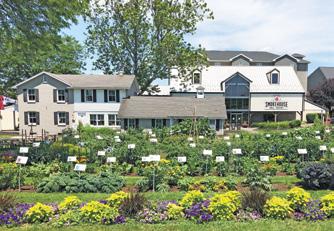
Visit the only officially designated “Heritage Site” Amish house. As you walk through the nine rooms with your guide, unravel the riddle of Amish clothing, life without electricity, and eight–grades–in–a–room education as you sit at authentic Amish school desks.

This officially designated “Heritage Tour” is a rare opportunity to meet and talk to the Amish personally. On this exclusive tour you will go right into the barn on an Amish farm at milking time, visit with an Amish artisan at his workplace, and then enjoy a personal visit and conversation right in an Amish home.
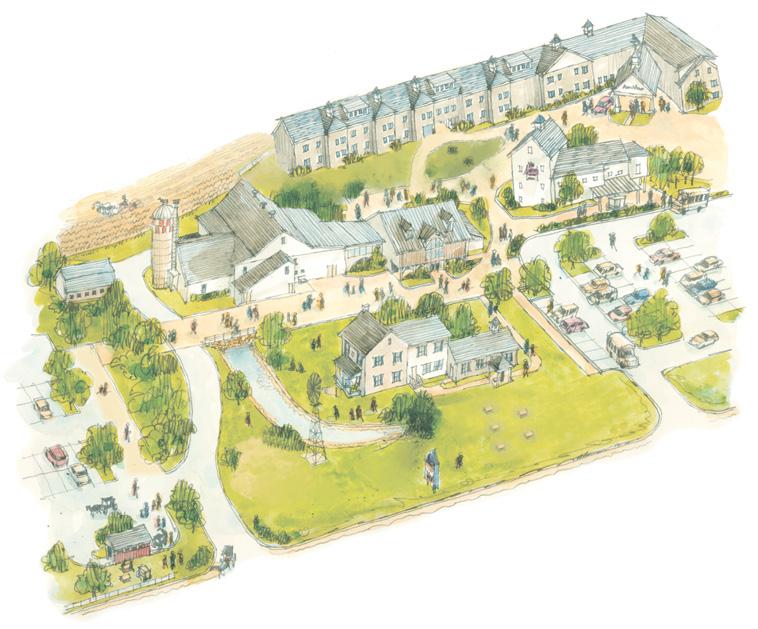
AMISHVIEW INN & SUITES
SMOKEHOUSE BBQ & BREWS THE BARN & HEARTH SHOP RESTROOMS & ATM
AMISH COUNTRY HOMESTEAD
AARON & JESSICA’S BUGGY RIDES
Aaron & Jessica’s drivers are happy to share life stories and answer questions.
Please see right hand page.
Find home décor, home goods, and kitchenware. Plus, locally made foods and baked goods. You’ll also find Amish mementos from straw hats to Amish dolls.

A Top Hotel in Lancaster County
The place for the perfect adult-only getaway or family vacation with indoor pool and hot tub, fitness center, and hot hearty breakfast. Our rooms and suites all feature kitchenettes, and many rooms feature clawfoot soaking tubs, and farmland views.
Adult-Only AND Kid-Friendly Buildings
The family-friendly East Building includes a wide array of beautiful, award-winning rooms, suites that are newly renovated as well as a pool and arcade that will satisfy the requirements of any family. The adultsonly West Building features elegant Grand King rooms with clawfoot soaking tubs and guaranteed farmland views - fulfilling the needs of adults seeking a tranquil escape.
Complimentary Hot Hearty Breakfast Buffet Lancaster’s best complimentary hot breakfast buffet includes made-to-order omelets, eggs, and waffles along with endless helpings of bacon, sausage, country potatoes and much more. Plus, don’t forget tasty bakery items from our own Miller’s Bakery. Menu items subject to change.
Other Amenities
Every room or suite includes a kitchenette with refrigerator, microwave, sink, and coffee maker. Bathrooms feature lighted make-up mirrors, hair dryers, and the Tarocco line of shampoos and soaps. Plus, complimentary Wi-Fi. Book today as there are so many things to do on Plain & Fancy Farm.
Get the Whole Story at: AmishViewInn.com • 1-866-735-1600
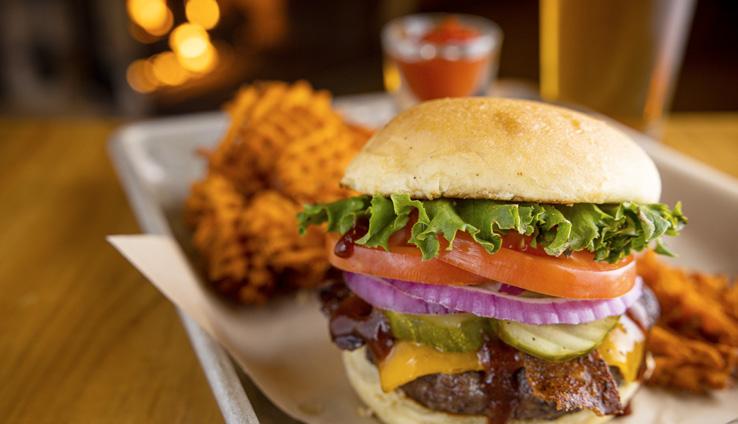
A fun and relaxed dining experience in the heart of Lancaster County at Plain & Fancy Farm, offering entrées with smoked meats, grilled fish and steak; sandwiches; house made sauces; and more. Local favorites and meats smoked low n’ slow pair perfectly with our selection of local beer, wine, and hand-crafted cocktails. Locally owned.
Any Sandwich, Entrée, or Platter
Valid for up to 4 adult sandwiches, entrées, or platters for dine-in only. Not valid on daily or other specials, Family Feast, Prime Rib, takeout, holidays, or with any other offer, special or group rate.
Expires 08/31/25. PLU ACNJ25

Welcome | Reservations Accepted | Takeout Available (717) 768-4400 or visit SmokehouseBBQandBrews.com
For over 250 years, visitors coming into Lancaster County from the east on Route 30 have traveled through a small town known as Paradise, just one of the many intriguing town names in the area. Officially, Paradise Township adopted the name during its organization in 1843.
Different sources credit different people with naming the area. Some say that the name Paradise was given by Joshua Scott, who later became
known for his map of Lancaster County. Standing in the middle of a road admiring his surroundings one day in 1804, he remarked that the town should be called Paradise, because its beauty made it seem like one.
The story of Paradise and its first settlers goes all the way back to Europe, to the area of the Palatinate in Germany. Here many Protestants had settled following the declaration of King Louis XIV that all Protestants in France would
be persecuted. With fears of invasion by the army of France looming, many of these people decided to accept the invitation to settle in William Penn’s colony of Penn’s Woods in the New World. In 1708, Daniel Fierre (Ferree), along with his family and mother Mary, went to England to obtain citizenship papers before proceeding to New York. By 1712, these French Huguenot settlers had secured land in Pennsylvania, in Lancaster’s Pequea Valley. They were the first white people in the area and lived peaceably with chief Tanawa and the local Indians. Mary Fierre died four years later at the age of 63. Hers became the first grave in the family’s cemetery. If you ride the Strasburg Rail Road, you will pass her gravesite at Carpenter’s Cemetery, one of Lancaster’s oldest.
The origins of Route 30, also known as the “Lincoln Highway,” go back to Lancaster’s colonial days when this frontier county needed a communication route between it and the provincial capital of Philadelphia. At that time, the first “planned” road between




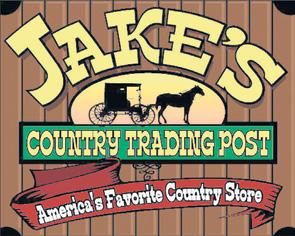








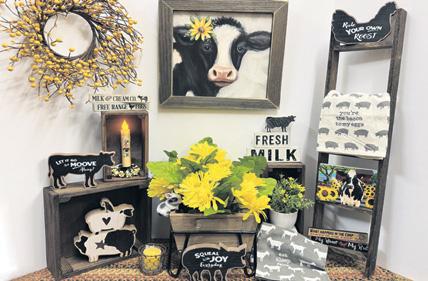



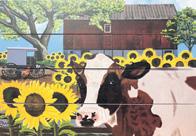



Voted a LNP Lancaster County Reader’s Choice Buffet 2024, AND a 2024 USA TODAY 10Best Readers’ Choice Best Buffet in the US, Tripadvisor’s Travelers’ Choice Part Eatery. Part History Lesson.
Since 1929, Miller‘s has cooked from scratch and created dishes that you’ll go home and tell your friends about. From Lancaster County PA Dutch favorites to fresh baked desserts.
Buffet Dining OptiOns: Lancaster’s Traditional Smorgasbord OR Soup, Salad & Bread Smorgasbord. Plus, wine, beer and cocktail menu available.
O pen 7 D ays a W eek
Reservations Strongly Encouraged|Walk-ins Welcome
Reserve Online at Millers1929.com or call 800-669-3568.
Part Eatery. Part History Lesson.
Since 1929, Miller‘s has cooked from scratch and created dishes tell your friends about. From Lancaster County PA Dutch favorites
Lancaster’s Traditional Smorgasbord Soup, Salad & Bread Smorgasbord. Plus, wine, beer and cocktail
Valid for up to four adults on our Traditional Adult Smorgasbord Dinner. Not valid Saturdays, Easter, Mother’s Day, or Thanksgiving. Not valid with any other offer, special, discount, birthday offer, or group rate. Applies to Traditional Adult Smorgasbord Dinner only. Not valid on any other dining option. Must show coupon to server prior to dining. Not valid on prior purchases or vouchers. Expires 8/31/25. PLU ACNJ25


Reservations Strongly Encouraged|Walk-ins Welcome or call 800-669-3568.

Voted a LNP Lancaster County Reader’s Choice Buffet 2024, AND 10Best Readers’ Choice Best Buffet in the US, Tripadvisor’s


Valid for up to four adults on our Traditional Adult Smorgasbord Easter, Mother’s Day, or Thanksgiving. Not valid with any other birthday offer, or group rate. Applies to Traditional Adult Smorgasbord valid on any other dining option. Must show coupon to server Expires 8/31/25. PLU ACNJ25 Where you can find locally made items

Where you can find locally made items including hand-stitched quilts from Amish and Mennonite artisans, tasty Lancaster County baked goods and sweets, handcrafted jewelry, and specialty gift items. Eat at Miller’s and shop local.





Philadelphia and Lancaster was what is now Route 340. It was called the “King’s Highway,” and today we still call it the “Old Philadelphia Pike.”
As time went on, it became evident that the road could not accommodate the increasing traffic between Lancaster and Philadelphia. Since the cost of such a road was too much for the state to undertake, the company charged with building it was given the power to demand “reasonable” tolls from users. Investors received dividends earned from the tolls collected along the gates of the turnpike.
The 1792 Act went on to describe the construction of the highway, which was to be a bed of small crushed stones on top with larger stones underneath, rather than dirt, so as to prevent carriage wheels from cutting into the soil. Such a revolutionary system of road construction combined the ideas recently developed by a Frenchman and two Englishmen, one of whom was named John McAdam. We now take the term for paved roads or “macadam” from his last name. The


July 26, 2025
Join us for a day of living history at the Historic White Chimneys Estate and Farm. There will be house tours, carriage displays, open hearth cooking, crafts, food trucks, Amish barbecue, blacksmithing, battle reenactments and cannon fire! After, feel free to shop at the outlets in Lancaster!
For more information visit whitechimneys estate.com/living-history-events/ or call 717-442-1037. Tell them, “Amish Country News sent you”!
turnpike officially opened in 1795 and was the first long-distance, hardsurfaced road in the country.
The backroads around Paradise remain beautiful to this day, as the lush greens of the summer give way to the fall colors of the harvest season. So, during your visit to Lancaster, be sure to spend a little time in Paradise.

A is for Amish Buggy Rides 717-875-8304 | AmishBuggyRidesLancaster.com
Amish VIP (Visit–in–Person) Tour 717–768–8400 | AmishExperience.com
Anna’s Gifts & Sundries 800-669-3568 | MillersSmorgasbord.com
Country Lane Furniture (Tues & Thurs till 8pm) 717–867-5701 | CountryLaneFurniture.com
Crystal Cave 610-683-6765 | CrystalCavePA.com
Dutch Apple Dinner Theatre 717–898–1900 | DutchApple.com
Dutch Haven 717–687–0111 | DutchHaven.com
Gish’s Furniture 717–392–6080 | 717–354–2329 | Gishs.com
Good’s Store “Weekdays Only” | GoodsStores.com
Hershey’s Chocolate World 717–534–4900 | Hersheys.com
Jake’s Country Trading Post 717–687–8980 | JakesHomeAccents.com
Locally Made Food Shop 717–687–6621 | LocallyMadeFoodShop.com
Miller’s Smorgasbord 800–669–3568 | MillersSmorgasbord.com
Shady Maple Farm Market 717–354-4981 | Shady-Maple.com/farm-market/ Smokehouse BBQ & Brews at Plain & Fancy Farm 717–768–4400 | SmokehouseBBQandBrews.com
Village Greens Miniature Golf 717-687-6933 | VillageGreens.com
Water’s Edge Mini Golf 717-768-4653 | WatersEdgeGolf.net
For Plain People, Sunday is a day of rest, but there are many things to do in Amish Country on Sundays. Save some of these for your Sunday sight–seeing. A is for Amish Buggy Rides
717-875-8304 | AmishBuggyRidesLancaster.com
Aaron & Jessica’s Buggy Rides
717–768–8828 | AmishBuggyRides.com
Amish Experience 717–768–8400 | AmishExperience.com
Anna’s Gifts & Sundries
800–669–3568 | MillersSmorgasbord.com
Cackleberry Farm Antique Mall 717–442–2600 | CackleberryFarmAntiqueMall.com
Crystal Cave 610-683-6765 | CrystalCavePA.com
Dutch Apple Dinner Theatre 717–898–1900 | DutchApple.com
Dutch Haven
717–687–0111 | DutchHaven.com
Hershey’s Chocolate World 717–534–4900 | Hersheys.com
Jake’s Country Trading Post
717–687–8980 | JakesHomeAccents.com
Julius Sturgis Pretzel Bakery 717–626–4354 | JuliusSturgis.com
Locally Made Food Shop 717-687-6621 | LocallyMadeFoodShop.com
Miller’s Smorgasbord 800–669–3568 | MillersSmorgasbord.com
National Toy Train Museum 717-687-8976 | TCATrains.org/museum/ The Quilt Shop at Miller’s 717-687-8439 | QuiltShopAtMillers.com
Renninger’s Antique Market 717–336–2177 | Renningers.net
Shady Maple Farm Market 717–354-4981 | Shady-Maple.com/farm-market/
Smokehouse BBQ & Brews at Plain & Fancy Farm 717–768–4400 | SmokehouseBBQandBrews.com
Turkey Hill Experience 844–847–4884 | TurkeyHillExperience.com
Village Greens Miniature Golf 717-687-6933 | VillageGreens.com
Water’s Edge Mini Golf 717-768-4653 | WatersEdgeGolf.net

There really is no place quite like Lititz, and everyone should plan to spend some time there while in Amish Country.
Lititz Springs Park is a popular spot for locals, and the site for many community activities. Indeed, the town’s 4th of July Celebration, begun in 1818, is reputedly the “oldest continuing community-wide observance in the United States.” The Lititz story is tied to that of the Moravian faith in Bohemia. It was in the presentday Czech Republic that John Hus and followers founded the Moravian Church in 1457. Historians note that since this was 60 years before Luther’s Reformation, the Moravians may lay claim to being the oldest organized Protestant Church. But over the course of the Thirty Years War, its
200,000 members nearly disappeared. In the 18th century, a renewal of the Moravian Church came through the patronage of Count Zinzendorf of Saxony. He invited all those persecuted for their faith to come to his lands in Saxony.
As was the case with other persecuted religious groups in Europe, many Moravians sought freedom by taking the perilous journey to the New World, arriving in the early 1700s, with the main settlements becoming established in Pennsylvania and North Carolina.
Missionary work was integral to the faith, and preachers were sent from the Moravian community in Bethlehem, Pennsylvania. Zinzendorf himself arrived in America in 1742. A local resident, John Klein (Kline), was so moved by


July 26, 2025 9 am – 5 pm
Lititz Springs Park
That is a well-known and beloved setting for the Lititz Outdoor Fine Art Show—one of the few truly “fine art” shows in the area. The volunteers of our association are proud to be making this annual event possible. When visiting the show, you’ll view original artwork and fine art reproductions of over 130 artists, both local and out-of-state. Walking down the paths, enjoying the park’s atmosphere, visitors can browse in the booths of the artists and purchase their creations. Oils, acrylics, watercolors, drawings, ceramics and sculptures of different kinds can be seen and purchased at this show.
For more information and details please visit lititzpa.com/event/lititz-outdoor-fineart-show/ or call 717-626-8981. Tell them, “Amish Country News sent you”!
hearing Zinzendorf’s preaching that he made arrangements to transfer his lands over to the Moravian community in 1755. It was in the following year that the town actually got the name of Lititz, the German spelling for Lidice, where European Moravian reformers had taken refuge in 15th century. For about a hundred years, Moravian church members were the only people permitted to live in the town. A Brothers’ House and Sisters’ House were erected for the unmarried men and women, although they did not live communally. It was not until 1855 that non-Moravians were allowed to own their own houses.
The Brothers’ House played a role in the American Revolution. George Washington ordered it used as a military hospital between 1777-78. Some 1,000 soldiers were nursed here, about half of whom died and were buried nearby.
One name is linked forever with the history of Lititz—Julius Sturgis. It was Sturgis who opened the first commercial pretzel bakery in the New World in Lititz. The year was 1861, and the site at 219 East Main Street is on the National Register of Historic Places.

A tour of the bakery is unlike any other. Inside, you get to try your hand at pretzel twisting. It’s not as easy as it looks. Guests also may see the old brick bake ovens, as well as the more modern facilities. Schedule a tour by calling the bakery at 717-626-4354.

Ephrata, a small yet influential town, derives its name from Genesis, meaning “fruitfulness.” With a population of 13,800, it’s strategically positioned between Lancaster and Reading, serving as the gateway to Northern Lancaster County’s lucrative manufacturing sector.
Its history dates back to the 18th century Ephrata Cloister, founded by Conrad Beissel, which evolved into a thriving village. By 1871, Ephrata was described as “a well-built country town of about one hundred and twenty families, and very beautifully and healthily located.”
In 1848, Senator Joseph Konigmacher established the Ephrata Mountain Springs Hotel, a luxurious resort frequented by notable figures like Presidents Lincoln, Buchanan, and Grant.
A trolley system was built to connect the hotel with the town of Ephrata down
the hill. At its peak, the hotel could accommodate up to 500 visitors who would stay throughout the summer.
The Reading & Columbia Railroad was completed in 1883, and the town experienced economic booms through industries like cigar manufacturing, horse trade, silk, textiles, and shoes. Downtown Ephrata once catered to all needs, from groceries to hardware.
Today, Ephrata retains its historical charm with landmarks standing as important reminders of the borough’s history. The community’s first bank, Ephrata National Bank, still serves customers today behind its Georgian style structure designed by renowned architect, C. Emlen Urban.
Located near the town’s square sits the circa 1880’s railroad station, owned by the Ephrata Borough and serving as home to Mainspring of Ephrata, economic development corporation for the borough. The area
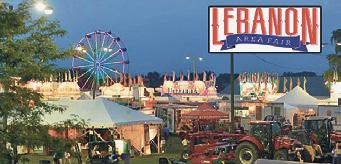
July 19 – July 26, 2025
It’s no surprise that the Lebanon Area Fair was voted Lebanon Valley’s Best Local Event by area residents; more than 50,000 attendees flock to the Fairgrounds each summer to enjoy the annual showcase of Lebanon County agriculture, great food, carnival rides, track events, and live entertainment!
For more information and details visit lebanonareafair. com/?utm_source=lancasterpalocal. com&utm_medium=referral&utm_ campaign=LancasterPALocal or call 717-273-3795. Tell them, “Amish Country News sent you”!
surrounding the station has been beautifully landscaped and is known as the Whistle Stop Plaza. Many events, services and even weddings are held at this popular gathering place. The community’s Welcome Center is also located in this building. From here, visitors and residents alike can download a historic walking tour through the Uniquely Ephrata app.
Recreation thrives with facilities like the Ephrata Rec Center, community pool, and the newly opened Ephrata Unleashed Dog Park. The WarwickEphrata Rail Trail and Heatherwood Bike Park offer outdoor activities, while quality education and healthcare are ensured through the Ephrata Area School District and award-winning Wellspan Ephrata Community Hospital.



Municipal services include police, code enforcement, and utility management, with the borough’s own electric company providing power.
Ephrata is experiencing some significant revitalization that will secure a vibrant, healthy town for future generations. The borough, under the auspices of Mainspring of Ephrata, completed a walkability project in the downtown area that enhanced pedestrian safety, and launched a Façade Improvement Grant Program and Revolving Loan Fund Program to improve aesthetics and help businesses to expand. The borough
Ephrata cont’d on page 39















































































































































































To Hershey
To Harrisburg
To York and Gettysburg
Bird–in–Hand Pg 14
Intercourse Pg 38
Paradise Pg 28
Strasburg Pg 40
New Holland | Blue Ball Pg 36
Lititz Pg 31
Ephrata Pg 32

Renninger’s

New Holland, settled in 1728 by John Diffenderfer of Heidelberg, Germany, is located in the fertile farmlands of Lancaster County. It is a charming small town similar to many towns in rural America, but its story goes back to well before the founding of our nation.
The unstable situation in Europe in the late 1600s spawned and nurtured the pioneer interest in the deep forest lands of Pennsylvania—60 miles inland from Philadelphia. In 1681 William Penn received his 40,000 squaremile land grant to settle King Charles’ debt to his father. The area now called New Holland was practically covered by virgin forests—sturdy timber of oak, ash, chestnut, and walnut.
By 1728, William Penn, had been dead for 10 years and his American colony, called Pennsylvania and was being administered by a proprietary governor while the sale of land was
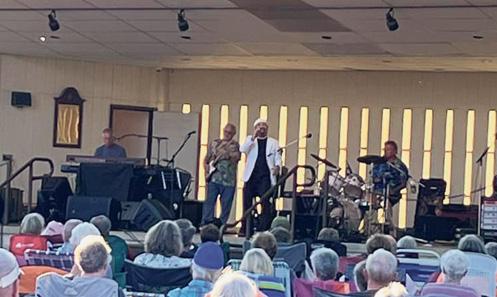
Wednesday, Saturday and Sunday evenings in July and August
formalized by patent deeds. In the case of one of the town’s early settlers, John Diffenderfer, the record shows that he applied for land to live on in 1728. It was surveyed and placed on the county map in 1735. The deed was finally issued to him on March 22, 1758 after 30 years!
The village founders were German, not Dutch. They were surrounded by English and Welsh Quakers, Episcopalians, a few SwissGerman Mennonites and some Scotch-Irish Presbyterians. The Amish arrived later.
The town was once known as New Design, a name given by Michael Diffendefer for his real estate development in 1750. But in 1802, when a post office was established and an official name was necessary, there was no dissension to naming the town New Holland. These grateful people remembered how extremely

Freedom Thrift New Holland 114 Ranck Church Rd. New Holland, PA 17557 Mon-Sat 9-5
Freedom Thrift on 30 2853 Lincoln Hwy E. Ronks, PA 17572
Mon-Tues 9-7
Wed 9-5
Thurs-Sat 9-7

Free entertainment in the New Holland Community Park. Check for our full schedule of Live Music.
For more information, please visit newhollandsummerarts.com/scheduleof-shows. Tell them, “Amish Country News sent you”!
kind the inhabitants of Holland were to them when they fled persecution and sought religious freedom in the New World.
New Holland was laid out as a “street town” in the typical European style of having the villagers live in a central location along both sides of the street, but each having an outlying plot of land to cultivate as an adjunct to his trade as a craftsman. Even today, the main street of New Holland has major “kinks” or bends in it. Unsympathetic visitors claim it looks as if the town were built along a “cow path.” But if one looks with a discerning eye, the street also follows the high ground. The land on the ridge was the driest, and in winter it would be blown clear of much of the snow. These settlers made the obvious facts of nature work for them rather than against them, offering a lesson for us all even today.

All proceeds support addiction recovery.

WIZARD OF OZ LANDS AT DUTCH APPLE!

THE WIZARD OF OZ is touching down in Lancaster as Dutch Apple Dinner Theatre brings the greatest family musical of all time to the stage. Dorothy, Toto and their friends the Cowardly Lion, Tin Man and Scarecrow are transported over the rainbow to adventures in Munchkin Land, the Haunted Forest and the Emerald City. Featuring the classic songs like Over the Rainbow, Ding Dong the Witch is Dead and If I Only Had A Brain, along with the beloved characters, THE WIZARD OF OZ will have the entire family captivated as they travel down the yellow brick road for an unforgettable evening.
This production of THE WIZARD OF OZ is a spectacular celebration of the classic 1939 MGM film. It’s a new, refreshed and lavish rendition of the beloved classic. Audiences young and old, seeing it for the first time or the fifth, will be dazzled by the brightly colored sets, charmed by its timeless score and enthralled with its breathtaking special effects. It truly is a wonderful show for the whole family. And whether it creates new memories or conjures them up from the past, everyone deserves to experience or relive the wonderful, whimsical and enduring story, THE WIZARD OF OZ.
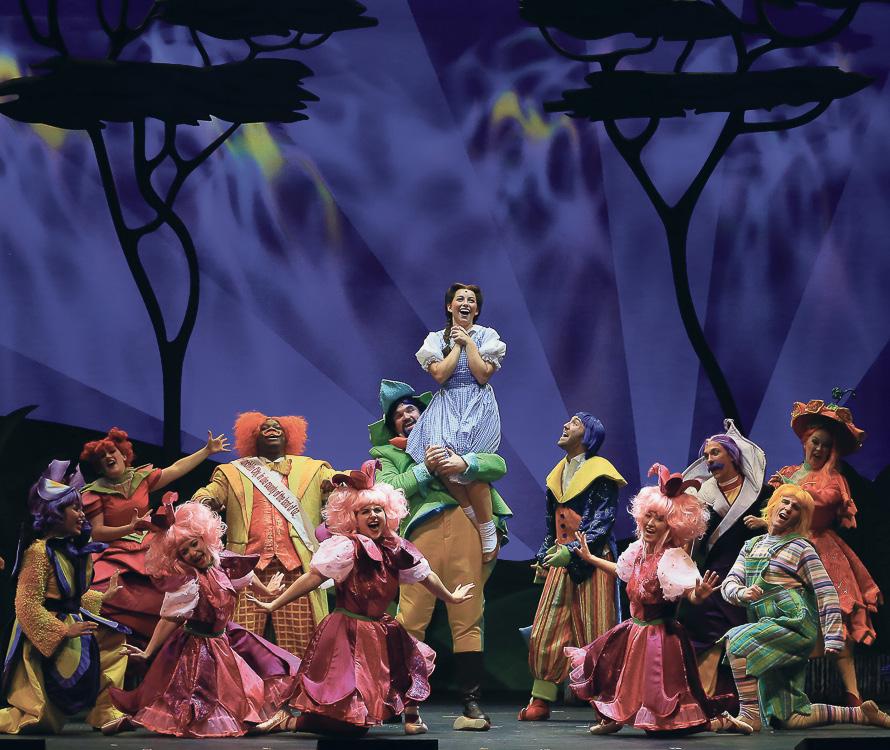


Follow the yellow brick road and the timeless tale about Dorothy, a farm girl from Kansas, who travels over the rainbow to the magical Land of Oz only to find there’s no place like home. Songs from the iconic MGM score include Off To See The Wizard, Munchkin Land, and Over the Rainbow.











June 17 6 p.m. - 8 p.m. The Cats Pajamas Live Music Nights are set to become your new Thursday night tradition! These outdoor concerts on the lawn bring together great music, delicious food, and a relaxed atmosphere under the stars. For more information visit discoverlancaster. com/events/live-music-nights-at-plainfancy-farm-ft-the-cats-pajamas/ or call 717-768-4400. Tell them, “Amish Country News sent you”!
Probably no other town in Amish Country can claim its fame is owed largely to one simple thing— its name. For years people have sent letters home with the name stamped boldly on the envelope… Intercourse, PA. There are several explanations for the name, and they are woven into the brief history that follows.
In the beginning, of course, there was very little here, just settlers arriving in the New World from Europe. Back around 1730, the Old Provincial Highway (or Old Philadelphia Pike, Route 340) was laid out to connect Philadelphia with the inland town of Lancaster. Conestoga wagons, pulled by six to eight horses, hauled supplies and freight back and forth between the


two cities. Providing rest for travelers and horses, taverns sprouted along the way, becoming centers for news, gossip, and business transactions.
And that is how the town got started when the first building, a log tavern, was constructed in 1754. The Newport Road, a former Indian trail, came from Newport, Delaware to the south, and it is believed that because of these intersecting roads the tavern took “Cross Keys” as its name.
That was true at least until 1814, when it was named Intercourse in a real estate scheme to establish a more sizable town. George Brungard had acquired 48 acres of land north of the roads in 1813. He attempted to lay out a town site and divide it into sections

for sale by a lottery, advertising “151 handsome building lots of $250 each to be drawn for by number.”
The newspaper advertisement stressed “the great importance of so many turnpikes and great leading roads intersecting at and near this place.” As one writer has noted, in those days “intercourse had a common usage referring to the pleasant mutual fellowship and frequent intermingling which was so much more common in the informal atmosphere of the quiet country village of that day.” There was no hesitancy on the part of the United States Post office Department to accept the name ‘Intercourse’ since it meant a commercial or trading site.
But back to our story and Brungard’s scheme. Although lotteries had been used for many years to sell various things, his real estate lottery failed, and most of the land was combined into one tract. More recently, in 1971, another person tried to take advantage of the town’s name and sell one-inch square plots of property to visitors. This plan proved to be a flop as well.
In the old days, there were only five houses, counting the inn, and the town grew slowly. But by 1880, Intercourse had 54 homes and a population of 280. Communications improved with the arrival of the post office, and later the telephone.
Getting the first post office up and running was a difficult matter. The main problem was finding a building and someone willing to perform the duties of a postmaster. The first,
Benjamin Fraim, performed his duties from the Cross Keys Tavern, and may have had a job working there, since “his income, based on a percentage of the postal transactions for the year ending 1829 was only $8.21.”
Over the years the post office moved among stores or restaurants whose owners hoped visits by residents would increase their business.
The local stagecoach service apparently started around 1898. It was “a single horse conveyance similar to a market wagon, with a roll-up curtain and double set of seats.” The stagecoach brought items from Lancaster City for local Intercourse businesses, and even picked up milk, butter, and eggs for delivery to Lancaster restaurants and industries, including an ice cream plant. One history of Intercourse notes that when it snowed, a bobsled was used instead. “When the driver knew of passengers beforehand, their
comfort was added to by many a hot brick heated the night before in the oven, and wrapped in newspaper to preserve its warmth.”
As the days of the dirt road drew to a close, so too did the stagecoach days with the Rowe Motor Truck service started by Coleman Diller in 1910. In 1923 the Penn Highway Transit Company was organized and initiated bus service to Lancaster. It is noted that “many of the Amish residents of the area were anxious to see the line started, but did not care to subscribe to stock. Instead they liberally bought books of tickets which were really prepaid bus fares.” By 1924 enough money was raised to buy a Mack Auto Bus for $6,800. It held 25 passengers and even had solid rubber tires!
Since the town never really got to be “too large,” it has retained much of its sense of community, from the little public library in a former one-room
Amish Country News is printed seven times per year. Fantastic articles! Money saving coupons! A guide to Amish Country! For an Amish Country News annual subscription, complete this form and send a check or money order for $30 to: Amish Country News, PO Box 414, Bird-In-Hand, PA 17505
Check an issue to start your subscription.
Spring (April/May)
August
September
October Winter (Nov/Dec)
school to the volunteer fire company. Surrounded by farms, the town has grown little and aretains much of its former charm, even when thousands of visitors descend upon it during the tourist season.
Many residents and visitors enjoy the atmosphere of this small town, a place where family, community, religion, and hard work are still important values. The village of Intercourse has certainly changed over the years, but it has changed slowly, and “sometimes the things that grow the slowest are the ones that endure the longest.”
Ephrata cont’d from page 32
continues to strengthen the economy by promoting available leased space within commercial properties, attracting specialty retailers, and preserving historic buildings.
The borough’s commitment extends to preserving natural assets like the Ephrata Mountain, exploring plans for hiking trails and conservation easements to enhance community living. It is from this 200 acres of public wooded land that the healing waters flowed all those years ago to the Mountain Springs Hotel.
Ephrata continues to thrive as a fruitful community, blending its rich history with modern amenities for residents and visitors alike.




The area we know today as Strasburg was first settled by German-speaking Swiss Mennonites. After bargaining with William Penn in London, they came directly to Philadelphia from the Rhineland, arriving in September of
1710, on board the ship Maria Hope with a combined passenger and crew list of 94 persons. Thirty-six of the leaders were granted patent deeds from Penn’s property commissioners for 14,000 acres of land surrounding Strasburg. Some of the family names

August 8 & August 9, 2025
This is an annual community celebration of generosity with food and a quilt and variety auction to support the relief, development and peace work of the Mennonite Central Committee. The Friday dinner and Saturday breakfast will be take-out only. Mud Sales are a unique Lancaster County tradition to raise funds for local volunteer fire companies. For more information visit lancasterpa. com/event/gap-relief-auction-2/ or call 717-687-9470. Tell them, “Amish Country News sent you”!
are familiar to locals today, including John (Hans) Herr, whose house in Lancaster County is open to visitors and remains as the county’s oldest surviving dwelling (1719).


French fur traders opened up the first path through this area from Philadelphia to the Susquehanna River—known as “Minqua’s Path.” As early as 1716, when the first Conestoga wagon was used for hauling goods between Philadelphia and Lancaster County, it became known as the Conestoga Road.


During the next half century, traffic on this road increased considerably— and Main Street Strasburg was developed. The first buildings appeared in the village about 1733. Strasburg flourished in the 18th century primarily because of its location along the major wagon routes between Philadelphia, Lancaster and the Susquehanna River. Strasburg was one of the principal stopping stations and, with the heavy wagon traffic, there were as many as ten taverns here.
No doubt the religious nature of the first settlers was responsible for the village becoming a center for worship and education. In 1816, when the village was incorporated into a Borough, the name Strasburg was selected, undoubtedly named for the Cathedral City from which the Swiss Mennonites came, the Alsatian city of Strasbourg.
Wealthy doctors and clergy, and an interest in worship and education, made Strasburg a cultural and educational center for the region. The

first formal school opened in 1790, a classical academy where Greek and Latin were taught.
These academic enterprises were followed during the 19th century by a flood of schools. In 1823, by an act of the Legislature of Pennsylvania, an Academy was established in which “the languages, arts, and sciences will be taught.”
The year 1839 marked the founding of the Strasburg Academy at 37 East Main (the present day Limestone Inn Bed & Breakfast was the headmaster’s home and housed boarding students). The Academy gained the reputation of being one of the best academies in the country for both boarding and day students, and its students came from all over the East Coast and as far away as Cuba and Puerto Rico.
In 1841, a classical school for girls, the “Strasburg Female Seminary,” opened at 17 East Main. Such a school for girls was quite unusual at that time.
As Strasburg flourished, so did its neighbor to the east, Philadelphia. The commercial interests of Philadelphia pressured the State Legislature to improve the transportation network into their city. As a result, an internal improvements bill passed in 1826 to construct a series of canals. The Philadelphia and Columbia Rail Road was also incorporated with financing provided by the state.
With these undertakings, Strasburg residents became alarmed at the
possibility of losing their commercial position and from this concern emerged the Strasburg Rail Road. In 1832 a charter was secured from the Pennsylvania Legislature to construct a rail line connecting Strasburg with the Philadelphia and Columbia Rail Road main line near Paradise. Due to financial difficulties, the project was


delayed until finally put in running order in 1852. But this shortline between Strasburg and Paradise was not financially successful for many reasons, until it was revived to provide rides to visitors on authentic steam locomotives, thus becoming the focal point for all of the town’s train attractions.

Amish Paradise Trail - 3.2 mile ride through Lancaster county’s scenic back roads, past Strasburg Railroad, Amish farms and businesses.
Amish Roads - 5 mile ride through Lancaster county’s breathtaking landscapes, Amish farms, one room schoolhouses and Amish businesses.
Amish Grocery Run - 75 minute tour, includes 20 minute stop at a traditional Amish grocery store powered by propane lights and generators.
Private Covered Bridge - Enjoy a 9-10 mile tour through the heart of Lancaster county, this tour travels through an authentic covered bridge.







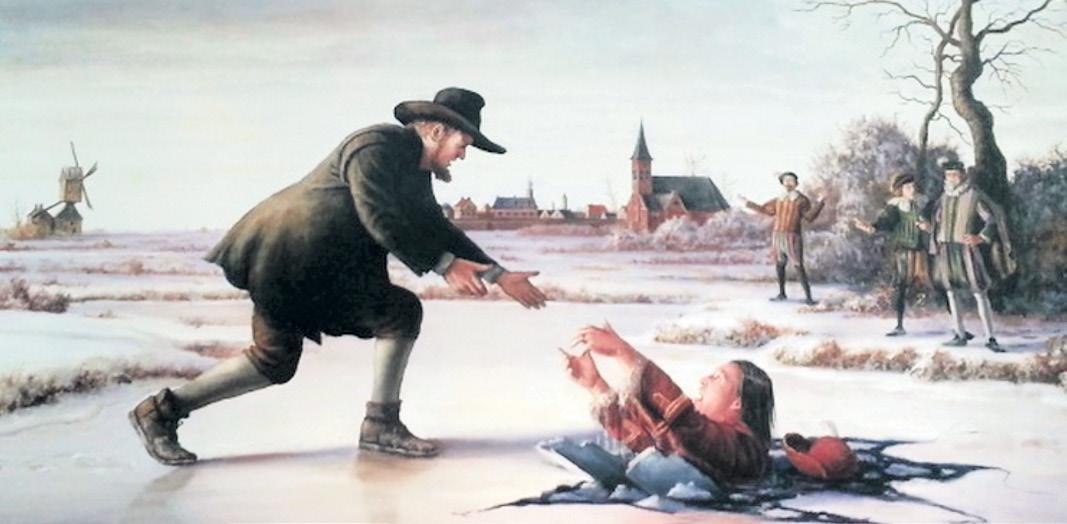
By Edward Blanchette
At the Amish Experience Theater, there’s a film called “Jacob’s Choice,” the story of an Amish boy and his struggle to decide whether to remain in the Amish faith or live in the “outside” world. Part of this presentation also involves the Anabaptist martyrs, the 16th century forefathers of the Amish and Mennonites, who were often imprisoned, tortured, and put to death for their religious beliefs in
PO Box 414 • Bird–in–Hand • PA 17505 717.768.8400, ext. 217 AmishCountryNews.com
Published by Dutchland Tours Inc.
Clinton Martin, Editor–in–Chief clinton@amishnews.com
For advertising information contact Edward Blanchette
Director of ACN & Business Development ed@amishnews.com • 717.344.0871
Tammy Johnson, Graphic Designer
290,000 copies distributed annually by subscription, and over 400 hotels, motels, information centers and businesses in PA Dutch Country. Copyright ©2025 All contents of this magazine are protected by copyright and may not be reproduced without prior approval of the publisher.

adult baptism and the separation of church and state.
One famous true story of Dirck Willems begins with his prison escape. While Dirck was fleeing across a frozen pond, his captor, in hot pursuit, fell through the ice into the freezing water. This would have been Dirck’s chance at escape and freedom, but following his Christian ideals, he turned back, saved the drowning man, and was then recaptured & taken back to town. Then eventually burned at the stake as a heretic. This powerful story can arouse some questions in people’s minds. Why did Dirck turned around to save the man who was chasing him? Why Dirck was put to death? Why did they kill him?” To summarize, he disobeyed the laws of the state and the church doctrines of that time. His ideas were considered radical and dangerous.
Some might ask, “Why didn’t he just change his beliefs?” the answer, “That some people believe so strongly their beliefs, that they’re willing to die for it. Two heroes in history, Gandhi and Martin Luther King. Here were two men who held strong beliefs, but did not use violence to bring about change. They, like the Anabaptists, suffered the consequences of their beliefs. Ultimately, they died for them.
Later, I thought some more about those questions. Surely 450 years ago there were people who had the same thoughts as some do today. Some found the words of Dirck Willems and his death at the stake a testimony to his faith. Others probably watched Dirck burn and wondered why he didn’t just utter the few words that would have saved his life and set him free.
Finally, I fear that we may look at these stories from the past and think of ourselves now, to be more enlightened & civilized. Yet nothing could be further from the truth. People are still imprisoned today all over the world, simply because of their beliefs and words they wrote or said to others. People are still mocked, even killed, because they are “different” from others, or don’t conform to “traditional values.” Children are wounded or die of hunger as adults fight for political advantage.
But the proper course of action is not to flee the horrors that threaten to overtake us, but rather to turn, confront them, and do what we know is right. While few may have this kind of courage, those that do can make a difference. That’s why we still talk about Dirck Willems 450 years after his heroic act of faith and love.
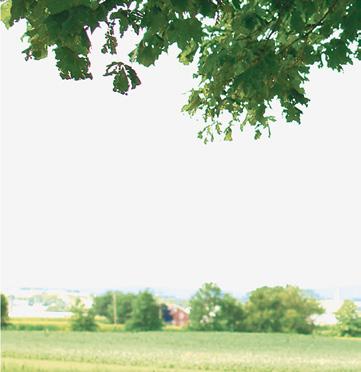

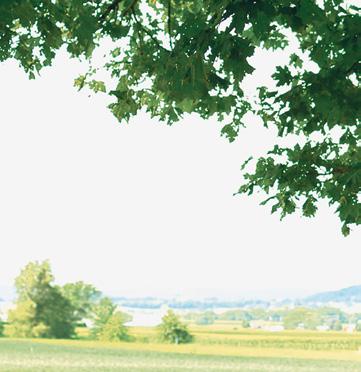
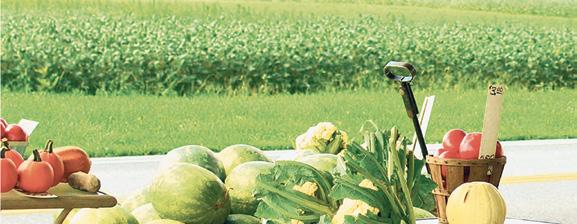


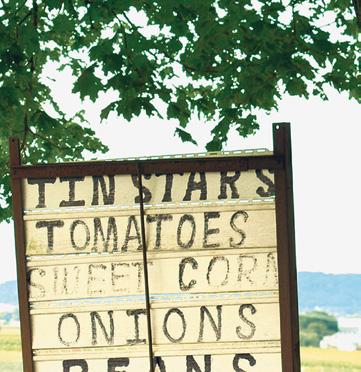



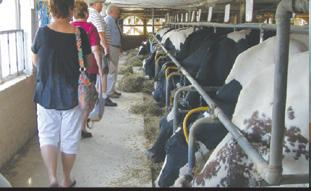



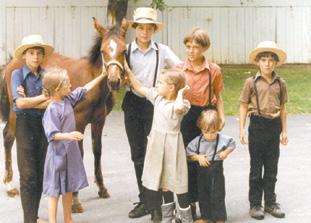
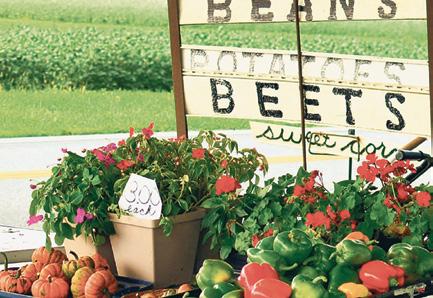

Amish Visit-In-Person Tour (3 Hrs.)
$55.95 adult, $45.95 child (age 6-12*)
* Children under age 6 not permitted on VIP Tour



Stop 1: The Amish Farm Observe the milking process and discover “Amish electricity” as you learn that the Amish do not milk cows by hand.
Stop 2: Amish Cottage Industry As the Amish population grows, more Amish turn to home businesses rather than farming. Visit an Amish workshop to see what they make and how they make it.
Stop 3: The Amish Home We’ll go to the home of one of our Amish neighbors for friendly conversation…a chance to sit, chat, and visit the Amish way.

Enjoy a 2.5–HOUR Experience featuring a traditional Amish Family-Style Meal, served in an Amish home.
$65.95 per person regardless of age*
* Small children must be in a car seat you provide.

































